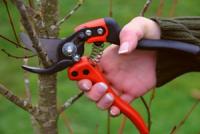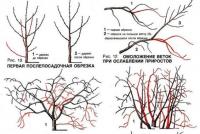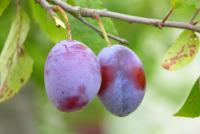How to grow tomatoes in the open. Planting and caring for tomatoes in the open field: Photo, Video - My Dacha .NET. Planting seedlings in a permanent place
When growing tomatoes in open ground, many gardeners - gardeners do not take into account that tomato varieties are subdivided into varieties for closed ground and varieties for open ground. Agricultural cultivation of tomatoes for greenhouses and open ground different. Tomatoes of varieties intended for greenhouses will suffer from temperature changes in the open field, it will hurt and pollinate poorly and vice versa low-growing varieties for open ground will not master the volume of the greenhouse and give a small crop. It will take several years before it turns out to pick varieties suitable for these climatic conditions.
What grades are suitable for an open ground
Peculiarities of growing tomatoes in open ground associated with a shorter growing season than when Therefore, for growing in open ground use stunted tomatoes, slightly less - medium growth. The most adapted for growing in the open field, stunted and early ripe - superdeterminant varieties. They are distinguished by a low location of the first inflorescence, over 4 - 6 leaves. Between the inflorescences is one leaf, or the leaves are missing. Tomato growth is limited to inflorescence. Super determinant tomatoes give the crop before the onset of adverse weather conditions. There are a few but - the fruiting period of such tomatoes is short, the quality of the fruits is not high, the fruits are not large, up to 100 grams.
Also for cultivation in the open field are suitable determinant varieties of tomatoes. These varieties are later, the first inflorescence is located over 6 - 7 leaves, between the inflorescences 1 - 2 leaves. Larger fruits, 120 - 140 grams, forms more inflorescences.
These groups of tomatoes are of limited growth type.
Landing dates
On a bed in an open ground, in middle lane Russia, planted on May 25 - June 5. In the northern areas, tomatoes are planted later - June 5 - 12, when the daytime temperature will not be lower than +14 +15 degrees and the danger of return frost will pass. In the southern regions, a tomato planting is made on May 15-18.
Soil preparation
The best for growing tomatoes are light-loamy, sandy, rich in humus, with neutral acidity of the soil. The beds for growing tomatoes should be protected from cold winds and warm up well.
Tomatoes can be grown in one place for no more than 2–3 years, since the same mineral substances are removed from the soil and diseases and pests accumulate in the ground. Good predecessors for tomatoes are: zucchini, cabbage, onions, carrots, annual herbs. In no case can not plant tomatoes after potatoes, peppers, eggplants and other solanaceous crops, because they have the same pests with tomato and. Return the tomatoes in place can be no earlier than in 3 - 4 years. To avoid damage to tomatoes by late blight, the Colorado potato beetle should avoid planting them next to potatoes.
It is better to prepare the soil for tomatoes in the fall: remove all plant debris, carefully select weeds, dig up to a depth of 25 - 30 cm, be sure to add organic fertilizers, at the rate of 4 - 6 kg. on 1 square. meter. If the beds for tomatoes are prepared in the spring, then digging is better to add humus. Also in the spring to make in the soil mineral fertilizers at the rate of: superphosphate - 80 grams, potassium chloride - 20 grams per 1 square. meter. Nitrogen fertilizers are best to be applied as a top dressing. If the soil is loamy or clay, then it is too heavy for tomatoes, so you need peat or well-rotted sawdust, 1 bucket per 1 square. meter. It is better not to overdo it with fertilizers, as this will cause an increased growth of the stepsons, the plant will stretch, bloom profusely and cause fruit to grow poorly.
In the spring, before digging, the ground should be shed with a solution of copper sulphate. To prepare the solution you need 1 tablespoon of the drug diluted in 1 bucket of water. Solution consumption 1.5 - 2 liters per 1 square. meter.
After the beds are prepared, they need to stand for 1 - 2 days in order for the earth to warm up and only after that to plant the seedlings.
A tomato seedling ready for planting should be strong, healthy, 30–35 cm tall, with a stem thickness of 0.7–1 cm, 7–9 leaves, and two well-developed floral tassels.
Before planting, seedlings should be treated with 1% Bordeaux mixture for the prevention of disease. In order for seedlings to lose as few roots as possible, when dredging them from pots, the ground in pots should be well shed the day before planting. The less the roots lose their seedlings, the faster they will acclimatize and start growing, which will ensure an earlier harvest. Sick and poorly developed seedlings reject.
The beds for tomatoes are low. Planted tomatoes tape way or square nesting. Undersized early ripe varieties Tomatoes can be planted according to the pattern of 30x40 cm; mid-ripening whiter rarely - 40x60 cm or 50x50cm. Tomato seedlings are planted in wells 15–20 cm deep and 20–30 cm in diameter. Wells are prepared in advance according to the chosen scheme, 1–2 handfuls of humus are put into them, mixed with earth and 1–1.5 liters of water is poured.
The seedling is placed vertically in the hole so that the edge of the nutritional cube is below the level of the garden and covered with earth until the cotyledon leaves. The soil around the bottom of the stem and the roots are compacted. Proper planting will allow the plants to quickly settle down and not lose flowers on the first hands. Planting seedlings in open ground is better in cloudy weather, or at least in the evening, to avoid burns.
Formation of tomato bushes
In the open ground are grown, as a rule, ripening and undersized varieties. Plants of such tomatoes form 2 - 3 stalks or 1 stalk if you want to get an early harvest. When dvuhstebelnoy formivka leave one stepchild under the first flower brush, and the other stepchildren are removed. When forming in 3 stalks, the stepchild under the first brush is left to grow and one more, the strongest. Forming a single stalk is to remove all stepchildren. The butchers are removed when they reach 5 - 7 cm. They are long, regularly, as they draw off nutrients, which affects the yield. Pasynka should be removed carefully, without the formation of wounds, because they can get a fungal infection. If the stepchildren have outgrown, it is better to use scissors or a sharp knife, leaving 1cm stump from the stepson. On tomatoes they not only cradle but also pinch, that is, remove the tip after setting 2 to 3 brushes on the shoot. Above the top brush leave 2 - 3 leaves, as the development of fruits in the brush occurs at the expense of the leaves next to it. All unbound buds are also removed. Pinching should be done in early August in order to accelerate the growth and ripening of the fruits left. Also need to remove the lower leaves. This should be done gradually, 1 - 2 sheets per week. By the time of ripening of the fruits of the first brush, there should be no lower leaves.
Care
When growing tomatoes in the open field, caring for them is pest control, frost protection, loosening the soil, pasynkovanie and so on.
To save tomatoes from frost, you can cover them with matting, paper caps, burlap, or use smoke fires and sprinkling. If a cold snap is expected to be long, then it is better to spud up the planted tomatoes. When the threat of frost disappears, seedlings must be freed from the ground.
To ensure the temperature and water-air regime of tomatoes it is necessary to avoid the formation of a soil crust, due to which plants lose a lot of moisture. For this, the soil is mulched. For mulching use: peat, straw, humus, old sawdust. By creating all the conditions for the growth and development of tomatoes, we ensure good harvest.
Feeding
A high crop of tomatoes is impossible without regular dressings. The first dressing is done 10 to 15 days after the tomatoes are planted in the soil. 10-15 grams of superphosphate, 5-10 grams of ammonium nitrate are taken on a bucket of water. Solution consumption 1 bucket per 1 square. meter. The second time they feed when the ovary has appeared, 10-15 grams of potassium sulfate, 5-10 grams of ammonium nitrate to a bucket of water. Organic fertilizers are also good for fertilizing: a mullein solution is 1:10, a solution of bird droppings is 1:20 for 20 bushes. Top dressing should be carried out in a timely manner, and for this you need to carefully monitor the condition of the tomatoes.
- With a lack of nitrogen leaves fade, plants grow poorly. With an excess of nitrogen, the plant on the contrary "fattens", there is too active growth of the stems and leaves.
- The lack of phosphorus is manifested by the violet shade of the leaves, and the excess of phosphorus by the yellowing of the leaves and the fall of the flowers and ovaries.
- If matte spots appear on the leaves, then there is an excess of potassium in the soil, and when it is deficient, the plants dry out.
- If the leaves are curled in tomatoes, a dose of potash and nitrogen fertilizers is necessary, and superphosphate should be excluded.
Top dressing is best done with irrigation. After feeding tomatoes spud and mulch with peat. It is also a good idea to add potassium permanganate to the irrigation water, 2 grams per bucket of water. This is well reflected in the growth, ripening, tomatoes are obtained more sugar resistant to late blight.
During flowering, foliar dressing should be carried out, spray flower brushes with solutions:
- 1 teaspoon baking soda and 1/4 teaspoon boric acid, cool.
- 1 gram of boric acid diluted in 1 liter of water.
These foliar dressings stimulate the formation of ovaries. They should be carried out only in dry weather. Also a good effect for setting fruit is given by spraying flower brushes with the preparations “Ovary” and “Tomato”.
Watering
The harvest of tomatoes depends on watering. If the plants lack moisture, the quality becomes worse.
Tomatoes are watered along furrows between the rows or under the root, avoiding water on the plants. Watering is repeated every 7 days. The soil should be soaked to a depth of 35 cm. After the appearance of the ovaries, during the pouring of the fruit, it is necessary to water more often and more, and always regularly. Irregularity of irrigation leads to cracking of fruits.
Pollination
Tomatoes produce enough pollen to pollinate their own flower and the neighboring ones too, but the quality of pollination directly depends on the weather, mainly on the air temperature. The quality of pollen is deteriorating, and the anthers are deformed if the temperature is below 13 degrees. Pollen loses viability, the flowers fall off if the air temperature is above 30 - 35 degrees.
In order to attract pollinators to insect plants, it is necessary to plant on the beds, between tomatoes, but the one-year old honey plants: coriander, basil, mustard. But even with good conditions for pollinating tomatoes, it is better to help them. During the flowering period, tomatoes should be shaken or tapped gently on the stem. This method promotes fruit sticking not only in the open field, but also in the greenhouse.
Weed control
It is not effective to fight weeds in any one way, it is better to approach this problem in a comprehensive manner. It is necessary to organize crop rotation, use for this plant, competing with weeds, drowning their growth - annual grasses, rye, wheat, peas and others. Use the method of mulching with paper, old roofing felt, black film. Well, of course, nobody has canceled the hand weeding.
Maturation
In the open field, in the middle lane, the fruits of tomatoes begin to ripen on July 10–20 early varieties, 1 - 10 August - in the middle.
To accelerate the ripening of tomato fruits can be done in the stem, its root part, through cleavage with a knife. Insert a wand into it so as not to overgrow
You can, pulling the plant up, slightly tear the roots and limit the plant nutrition, which will lead to the outflow of nutrients from the leaves and stems to the fruits.
You can also wear a plastic bag, with a hole for condensate drainage, on a brush of unripe tomatoes. The fruits in the bag are warmer, they are protected from late blight, grow and ripen faster.
In order to avoid defeat of tomatoes by phytophtora, it is necessary to collect fruits in a timely manner. If the weather forecast threatens temperature fluctuations and high humidity, it is better to collect all the fruits.
17.09.2016
Tomato or tomato is one of the most popular vegetable crops in Russia. And, by the way, one of the most difficult is to stably grow tomatoes in the open field and not every amateur gardener or even all professionals manage to get a good harvest from year to year. This is due to a rather specific biology of culture.
Tomato biology overview
Homeland of tomato - hot and arid regions of South America. It is perfectly adapted to moderately high temperatures and lack of moisture in the soil - especially if the plants retain a rod. root system (with seedless cultivation). On the other hand, tomato has some weak points:
- low cold resistance - at a temperature of about 10 degrees the plants cease to develop, and at 5 degrees they can partially die off the above-ground organs;
- a long growing season, during which the plants need a temperature of 16 (at night) to 25 (day) degrees. Wild tomato develops as perennial. Its fruiting is stretched in time. Therefore, it is quite difficult to grow a tomato in the open field - it is necessary to get an early abundant harvest for 100 days or less;
- sensitivity to high air humidity - at a high humidity numerous fungal and bacterial diseases of a tomato are activated, first of all - late blight;
- high requirements for mineral nutrition. The tomato is especially sensitive to the lack of phosphorus (although it consumes a little) and calcium. Calcium deficiency causes apical rot of tomato;
- a large number of diseases that are quite difficult to fight even in large fields and even more difficult in a small household plot, where people and domestic animals can always be near the plantings.
At the same time, it is realistic to grow tomatoes in the open field not only in the Moscow region, but even in Siberia or the Leningrad region. Experienced Gardeners and farmers can consistently get a crop of about 4 ... 6 kg per m2, depending on the selected variety, and using high-yielding hybrids - much more. Below will be described in detail how to achieve such results.
Variety selection
For cultivation in open ground, you should choose early ripe and, if possible, determinant varieties of tomato, which form a compact plant. Of these, we can mention varieties:
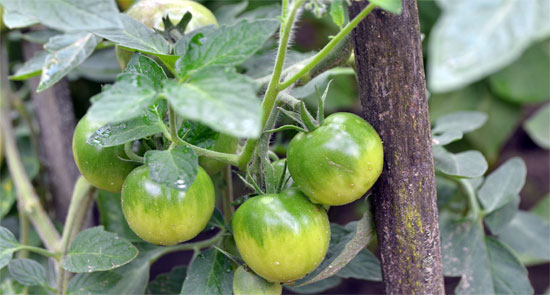
If you like small-fruited tomatoes, pay attention to the little-known variety "Aztec". It forms compact standard plants with very short and thick interstices and inflorescences with numerous small bright yellow fruits. However, you can read about varieties in the article "".
In most regions of Russia, tomatoes are grown by seedlings, and the seeds are sown on seedlings approximately 60 days before the seedlings are planted in open ground. You can learn more about seedlings from the article "Growing seedlings of tomatoes."
Terms of planting in open ground
Under the conditions of the Moscow region, seedlings of tomato are planted when the threat of late frosts is past - that is, from 1 to 10 June. If you can build at least a temporary film cover over the plantings and open / close it in time, you can plant the seedlings about 10 ... 15 days earlier. In other regions, landing times vary. More information you can get from the article "".
Landing technology
Neutral sandy and loamy soils are suitable for planting tomatoes in open ground. Tomatoes do not grow on heavy, poorly aerated and swimming, as well as saline soils.
Best for landing are the southern slopes. Plants on the southern slopes are protected from the north wind, and therefore it is possible to plant seedlings on them about 5 days earlier. The eastern and western slopes are also suitable, but to a lesser extent.
Tomatoes should not be grown in areas where tomatoes, potatoes or peppers have been growing for the last three years. It is difficult to observe such a four-year crop rotation on a small garden plot, but at least tomatoes should not be planted immediately after the Solanaceae.
Good predecessors for tomatoes:
- cucumber;
- onions and other onions;
- carrot.
If the soil is well cultivated, it is not necessary to apply organic fertilizers in preparation for planting.
The scheme of planting tomatoes in open ground depends on the type of variety and the intended method of forming plants (see the article ""). If we are talking about very compact standard plants, such as the Aztec mentioned above, they can be grown according to the 30 x 40 scheme. Some indeterminant varieties even when forming into one stem have to be planted in an amount of not more than 3, and when forming 2 and 3 stems - even in the amount of two pieces per 1 m2.
Thicken the landing should not be for four reasons:
- Caring for tomatoes in thickened plantings is extremely difficult;
- Plants will be deficient in sunlight and therefore will produce fewer fruits, and the fruits themselves will be smaller;
- If a growing tomato is pressed against the stem, peg or loop, with which it is tied, damages may appear on the fruit, which will make it non-marketable;
- Thickened planting is an easy target for fungal and bacterial diseases of tomatoes.
When planting in each well should be added.
- a handful of humus;
- tablespoon of superphosphate;
- half a liter of water.
All this is mixed with the soil.
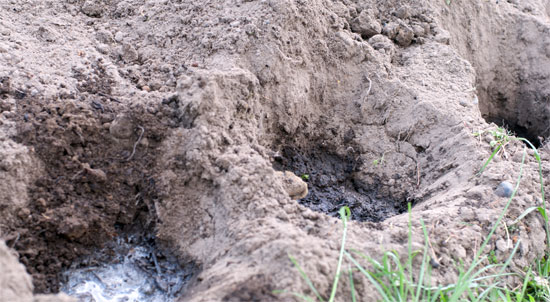
Planted seedlings so that the seedbed leaves are 1 cm above ground level. After planting, the ground around the plants is rammed and plentifully watered.
Work should be done in the evening or in cloudy weather. However, even in this case, the plants immediately after landing can lose turgor. At the same time their leaves wilted and sag. Do not worry: if you did everything right, the next day the seedlings will get a normal look, and after a couple of days it will start to grow.
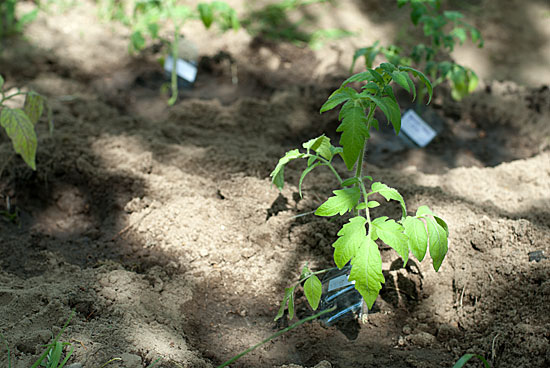
How to water the tomatoes?
When growing tomatoes by seedling, we damage their main root, and they form a root system of a fibrous type with a small depth. This is not bad, because in this case the plants will be able to absorb more essential minerals, which are located mainly in the upper horizon. On the other hand, this creates certain difficulties: the roots can not get water from a great depth. Therefore, in dry weather, young tomatoes necessarily need watering. Watering is necessary:
- warm water (temperature about 20 degrees);
- strictly under a root (it is impossible to rain);
- rarely, but abundantly (should be kept in the soil moisture within 60% of the maximum capacity) In practice, this means twice a week or once every 5 days if the soil is heavy.
During the mass filling and ripening of fruits it is necessary to water more often, but less plentifully. Sudden changes in soil moisture in such conditions can lead to cracking of fruits. The same applies to temperature drops, but it does not depend on us anymore.
Soil loosening
In the first weeks after planting, it is possible and even recommended to loosen the soil. At the same time, you improve the oxygen supply of the roots, reduce moisture loss due to the destruction of the soil capillary system and partially protect plants from root rot. About a month after planting tomatoes in open ground, loosening should be limited or stopped completely, since you will damage the roots. Of course, tomatoes quickly restore them, but from such loosening there may be more harm than good.
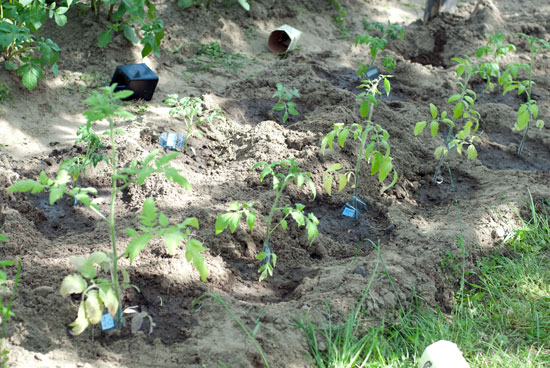
Mulching
Soil mulching allows:
- reduce the number of weeds;
- speed up soil heating in spring;
- reduce moisture loss;
- reduce air humidity in the landings;
- avoid contamination of the plant during rain and reduce the risk of plant disease;
- if the mulch is decomposed by soil microorganisms, provide additional nutrients.
Dark polyethylene films are traditionally considered to be the best mulching material for growing tomatoes in the open field in the Moscow region. In addition, straw and mowed grass give good results.
Top dressing
If you applied fertilizer during soil preparation and planting, fertilizing is not needed in the first two or three weeks. Then feeding is carried out every 15-20 days: the first with potash and phosphate fertilizers, the next with nitrogen, phosphorus and potassium in approximately equal proportions. In addition, foliar fertilizing with nitrogen, as well as a complex of macro and microelements, is effective.
Subject feedings quite extensive. Details on the feeding system for growing tomatoes in open field is described.
Masking
Tomato grazing is another extensive and, I must say, debatable topic.
In the bosom of each leaf of a tomato plant, a shoot continues to form over time, and it grows quickly. Continuation shoots and so on grow in the leaf axils of this shoot too. In general, not a steppe plant is such a local jungle, in which there are many leaves, many brushes, but nothing has time to mature.
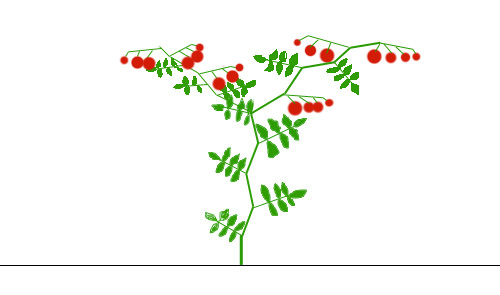
Growing and caring for tomatoes in the open field in most regions of Russia are aimed at obtaining early harvest. Therefore, tomato stepson, leaving 1-3 stem and a relatively small number of brushes.
If a tomato is formed into one stem, then all stepchildren are removed from it altogether, and the top is often pinched after several brushes. This is the way in which plants of indeterminate varieties form.
When forming in two stems, the stepchild is left in the leaf bosom under the first inflorescence - this bud has the greatest growth force. When forming in three stalks (in three stalks in the open ground, tomatoes are formed only in the southern ones), shoots are left to grow in the axils of two leaves under the first inflorescence. The rest are removed.
Remove stepchildren should be when they reach the length of 3-5 centimeters - such shoots easily pinch or break out. Shoots of greater length become stiff and must be cut. There is a risk of a bacterial or viral infection being transferred to the blade of a knife or scissors. They should be disinfected regularly. Themselves slices better sprinkled with ashes - they can also be a gateway for infections.
Protection against diseases and pests
When growing tomatoes in open ground, the greatest attention is paid to protection against diseases. Tomato pests in the open field are few and not too harmful. As for diseases, only late blight can kill 100% of the crop and ruin the farmer - despite the high level of agricultural technology and regular processing.
It should be noted that the cultivation of tomato in the open field in the Moscow region and the Central zone in general - the lottery of pure water. When growing, you are completely dependent on the weather. Just one week of rain and cold night fogs can completely deprive you of the harvest. Therefore, in the summer cottage you should always grow tomatoes in a greenhouse or at least a greenhouse. Industrial cultivation in the open field in the middle zone is generally impractical - the risks are too high. For this there is the Krasnodar Territory.
Agrotechnical measures to protect the tomato
- Growing up resistant varieties. Unfortunately, there are few disease-resistant varieties and hybrids, and most people do not have the best taste. Many varieties with excellent taste, on the contrary, are affected by blight and other pathogenic fungi very easily - for example, a terrific tomato "" or the beloved Heart of many. We still grow them - especially as.
- Compliance with crop rotation is better than not less than four fields. If tomatoes return to the same place only after three years, the susceptibility to diseases decreases sharply. True, not in the conditions of summer cottages, where, within a radius of 100 meters, a dozen infection foci are carefully grown every summer.
- Removal from planting potatoes. Many diseases in tomato and potato are common.
- Removing and burning plant residues and deep processing (digging or plowing the soil) can destroy most of the infection reservoirs.
- Presowing treatment of tomato seeds. Some pathogens are stored as mycelium or spores on the surface of the seed coat. Seed treatment before sowing tomato seedlings solves this problem.
- Introduction of optimal doses of fertilizers. With excessive nitrogen fertilization, the tomato grows rapidly, but at the same time, the cell walls of the cells of the leaves and stems remain rather thin. Such plants are more easily affected by pathogenic fungi.
- Optimum landing pattern and timely pasynkovanie. In thickened landings are created optimal conditions for the development of fungal and bacterial infections
- Regular disinfection of inventory, pegs, garter strings, etc. On the blades of knives and garden tools often "move" bacterial infections. Many of them can penetrate inside the plant only through wounds, and the knife or scissors for the pinning is the easiest way.
- Timely and moderate watering at the root. On the one hand, plants should not lose turgor, and on the other hand, the air should remain dry.
- Remove yellowed lower leaves, damaged leaves, leaves that lie on the ground, as well as affected aerial organs, including fruits. Everything remotely burned or thrown away.
Compliance with these rules does not guarantee you anything, but gives a chance. If the disease appeared (and they appear, do not hesitate), you can only rely on the treatment of fungicides. This is a very broad topic. Therefore, when there are obvious signs of disease, start with the article "Diseases of tomato, photos and description." Find what you need and go to the page with an article about a specific disease - detailed recommendations on drugs and dosages there.
Harvesting
If you have something to collect, you are well done. No, really - on the cultivation of tomato in the open ground, many agronomists broke off. I heard a bunch of such stories back in college, and then too. This is a complex culture.
![]()
In general, after setting, the fruits usually grow for about a month, and then another 10 days are sown. One of the stages of ripeness is the so-called milky ripeness - the fruits become light, almost milky. Starting from this stage, they can be safely removed - they easily ripen removed. Moreover, it is even recommended. Ripening tomato fruits produce ethylene, which accelerates the ripening of fruits nearby, but inhibits the development of new brushes. True, the fruits ripened on the bush are tastier.
Rip on tomatoes better in a moderately cool and dark place. The window sill is not very good - it is hot there and the tomatoes can dry. Among the ripening fruits you can put a pair of ripe - they will allocate a large amount of ethylene and a little bit of other phytohormones, accelerating the ripening of nearby ones. Well, you should also regularly remove the tomatoes, which appeared signs of blight, anthracnose and other diseases.
That's all. If I missed something or you disagree with something, write in the comments, I will be glad. Successes!
Tomato - this is one of the most favorite crops, which is found on the site of almost any summer resident. To harvest this extremely tasty fruit is fully pleased, planting a tomato must be correct.
Absolutely everything about growing your favorite tomatoes without watering, as well as their feeding and planting in open ground or in the greenhouse is impossible to know, but everyone who dreams of a rich harvest should have the basic secrets of nursing.
Choosing the right variety
A variety of tomatoes is amazing. Fruits can be small, large, medium, elongated, round, pear-shaped, ellipsoidal, oval, and similar to the heart. The color scheme is also impressive. After the familiar red tomatoes go orange, white, yellow of all shades and even almost black.
Any experienced housewife will tell not only everything about the cultivation of her most beloved variety, but also the fact that not every fruit is equally good in a salad and for harvesting for the winter.
Table dressing mixtures for tomatoes.
Therefore, in addition to the selection of early or late varieties of tomato, you need to take into account its further purpose. For example, "Tiger", "Budenovka" and "Pink Honey" are best used fresh in salads, and the varieties "Scarlet Sails", "New Year's", "Novice" are ideal for future preparations.
- "Eugene".
- "Aurora".
- "Red Sun".
- "Fat Jack."
- "Little Prince".
- "Hurricane".
- "Admiral".
- "Dandy".
- "Spring drops".
- "Shedi Lady".
- "Tsarskoye Selo".
- "Harmony".
- "Admiralty".
Tomatoes late varieties:
- "Vladimir F1".
- "De Barao".
- "Giraffe".
- "Cosmonaut Volkov".
- "RIO GRAND".
- "Titanium".
- "Date fruit".
- "The finish".
- "Farmhouse pickling."
- "Miracle of the market."
- "Octopus F1".
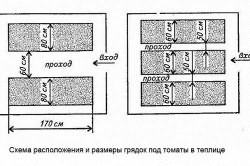
Popular pink varieties:
- "Demidov".
- "My family".
- "Oh la la."
- "Moscow pear".
- "Handsome".
- Supermodel.
- "Petrusha gardener".
- "Scarlet Candles".
- The Pink Stela.
- "Slav".
- "Monastic meal".
- "Batyana".
Most tasty varieties for open ground:
- The Golden Queen.
- "Hope".
- "Ballerina".
- "Uncle Styopa."
- "Ivan Kupala".
- "Karatinovy."
- "Laura".
- "Kemerovets".
- Scarlet Mustang.
- "Pickle delicacy".
- "Siberian Trump".
- "Sensei".
- Scheherazade.
- "Pudovik."
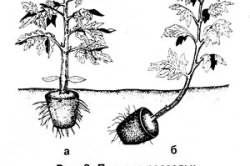
The best varieties of tomatoes in the greenhouse:
- "Yarilo".
- "Blagovest".
- "Friend".
- "Scorpio".
- "Gina."
- "Funtik."
- "Semko-Sinbad".
- "F1 Union 3".
- "F1 Union 8".
- "Semko-Sinbad".
- "Red cheeks".
- "Pink cheeks."
- "Cavalier".
- "Shustrik F1".
Tomatoes for the northern areas:
- Verlioka.
- "De Barao".
- "Olya F1".
- "Ural F1".
- "Admiralty".
In addition, it is possible to select specially tomato varieties for wet soil, plant height, and even for transportation or long storage.
Proper seed preparation
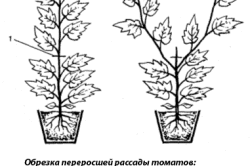
Proper planting of tomatoes always begins with a very thorough preparation of its seeds. One of the interesting and effective tips for growing tomatoes is the effect on the seeds of a contrasting temperature. To do this, they are soaked for 12-15 hours between 2 layers of wet matter. The temperature should be around 20ºС. Then they are placed in the refrigerator for 8-10 hours. This procedure is carried out cyclically for 2 weeks. Thanks to this method, all weak seeds perish. Tomatoes, the cultivation of which began with such hardening, always have high shoots and rich harvest.
For sowing seeds in the ground it is necessary to prepare the following tools and materials:
- Seeds.
- Soil for seedlings.
- Peat cubes or any available container with a depth of 4-5 cm.
- Watering can.
- Otstoyannaya water.
- Cellophane film.
- Spray.
- Tablespoon.
- Ruler or cardboard with a smooth edge.
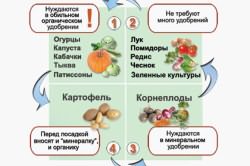
Step-by-step work:
- In the peat cubes or their capacity to pour moistened soil so that up to the top remained about 1 cm.
- Soil compacted.
- Using a spray bottle to moisten the surface of the soil
- If capacity is used, a 2x2 cm grid is drawn on the ground with a ruler or cardboard. This step is skipped when sowing in peat-bricks.
- Planting tomatoes produced by the scheme 2x2 cm.
- After the seeds are distributed, they are sprinkled with dry soil for 1 cm and compacted lightly with a tablespoon.
- The containers are covered with cellophane film and placed in front of the window.
As soon as the very first loop of shoots appears, without waiting for the remaining ones to appear, the container is immediately rearranged to a cool and bright place. Close to the glass seedlings better not to put. She is cold there and will not absorb food. The film is removed during the day.
After disclosing the seven-leaf leaves, the seedlings switch to independent feeding using their own root system. During this period, timely top-dressing with mineral fertilizers is very important. Of those offered on the market, you can use the following: Kemira-suite, AVA, Uniflor-growth. The film is removed completely. Watering tomatoes should be moderate with a watering can.
Proper lighting is important as much fertilizer, because at this stage the formation of a plant development program takes place. Fluorescent lamps placed at a height of 7-10 cm above the seedlings. Approximately 6-8 weeks after emergence, tomatoes can be planted in open ground or a greenhouse.
Growing tomatoes in the greenhouse
In order for the tomatoes in the greenhouse to feel good, not to hurt and give a generous harvest, you need to prepare the greenhouse itself for the season. Planting tomatoes produced in early May. At this time, the nights are still cold, so the greenhouse must have a double layer of film. It is important to make vents on all sides, to remove the top layer of soil, and to sanitize the remaining earth with copper sulphate. If the cultivation of tomatoes in greenhouses is planned in the winter, then you need to take care of additional heating and lighting.
Table of neighborhood vegetables.
The beds are prepared a week before planting the seedlings. The soil is loosened, the weeds that have appeared are removed, and humus is introduced. For poor soil per 1 m², a full glass of charcoal and 5-7 kg of humus will be needed, for fertile soil - 3-4 kg of humus.
Tips for growing healthy and productive tomatoes in the greenhouse are simple but important:
- The soil for planting should be heated.
- Seedlings should not be planted too deep.
- Nitrogen fertilizer should be in moderation.
- Planting and care must be timely. It is necessary to plant tomatoes in the moistened soil on a cloudy day or in the evening. Yellowed and diseased leaves are removed immediately.
The beds are usually broken along the greenhouse. Their width is about 50-90 cm. The quantity depends on the parameters of the greenhouse itself. Between the beds, a passage of 50-70 cm is constructed. Between the tomatoes, a distance of 40-60 cm is left. The scheme of planting this crop in the greenhouse is determined by the method of forming the plant and its variety. The traditional scheme looks like this.
Experienced growers are advised not to irrigate in the very first days after planting the crop in the greenhouse. You need to wait a week until the culture takes root. In the future, it is important to adhere to the optimum water temperature for greenhouse tomatoes. Greenhouse tomatoes are watered with water at 20-22 ° C. Before the flowering phase, the plant is watered after 3-4 days, with about 5 liters of water needed for 1m². During flowering, watering increase to 10 liters per 1m². Best of all greenhouse tomatoes watered at the root. This should be done in the morning, and not in the evening, when condensate forms.
Another major condition for obtaining a rich harvest is maintaining moisture and optimal temperature conditions. Tomatoes are not afraid of drafts. You can air the greenhouse in any way: open the ends, wrap the film at the bottom, open the top and side windows. Be sure to air the greenhouse 2 hours after watering, which is very important especially during flowering. Wet pollen cannot easily get into the pestle, so pollination will not occur.
Growing tomato in the ground
Under the planting of tomatoes in the ground take away an open sunny place, reliably protected from cold winds. Raw and low areas with close groundwater flow, which create very unfavorable conditions for the root system of a culture, are unsuitable for this purpose.
Do not recommend planting tomatoes where his predecessors were eggplant, pepper and physalis. Do not plant 2 years in a row and a tomato in one place. Potatoes, carrots, zucchini, onions, pumpkins, cucumbers and cabbage are considered good precursors.
Before planting the plants prepare the soil. It is disinfected and fertilized. The simplest and most affordable way to fertilize the soil is a mixture of ash and compost, at the rate of 1.5 cups of ash per full bucket of compost. This mixture is well watered furrows or holes.
Planting seedlings is best done in the evening. It will get stronger overnight and will transfer the procedure much easier. For planting dig trenches or separate pits. Next, carefully remove the bushes from the seedling containers and transfer to the prepared place along with a clod of earth. It is extremely important not to damage the root system. For painless extraction, the plant is watered abundantly about an hour before transplanting. The distance between the tomatoes in the ground and their beds is made similar to growing a culture in a greenhouse.
Ground tomatoes are watered immediately from the first time after planting. After watering it is necessary to gnaw the earth between the rows of plants. It perfectly saturates the soil with oxygen. This procedure will improve the whole process of growing a crop and ripening its future fruits. If you water the tomato irregularly, then there is a high probability of defeat with vertex rot and fragility of the plant itself. Mulching around the culture will avoid the rapid evaporation of moisture from the soil.
Care culture
A full care of tomatoes, both greenhouse and unpaved, we do not think without the rule of 3 "P" - garter, pasynkovanie, dressing.
Garter plants can be made in different ways. In small areas for tall tomatoes it is best to use a garter-pyramid, in areas with frequent winds - support "Brace". The figure shows schematically the supports with the symbols: 1 - number, 2 - bandage, 3 - bracket. Also for soil crops, you can use a garter on a trellis type of grape or the easiest and most affordable way, using a regular peg and rope. For greenhouse crops, frame or linear trellis are mainly used.
Masking is a necessary procedure when growing tall varieties of tomato and hybrids. If you do not stop the growth of the stem on its additional shoots, then this vegetable culture the entire supply of nutrients will be spent on building up the vegetative mass, to the detriment of the growth of the fruit. On low-growing varieties, this procedure is not necessary. They have, the more stepchildren, the richer the yield. Masking is usually carried out in the morning, so that all the wounds heal up until the night before the plant. First remove the lower stepchildren. Cut them off with scissors, a knife or pinch off with nails. Finding stepchildren is very simple - this is a side shoot growing from the leaf bosom. That the bush grew in one stalk, remove all stepchildren. When forming a culture in two stems, you must leave the main shoot and the strongest extra. More than three stems in the bush are not recommended to grow. It is necessary not to allow an unnecessary additional shoot to outgrow too. Inspect the plants for staining better once a week.
To feed the plants must be throughout the season. Perform this procedure is better monthly. Compost and all kinds of fertilizers need to be applied between the rows. Any fertilizer is better to make a couple of weeks before disembarking. It is necessary to choose fertilizers with a small nitrogen content in relation to other major components.
Collection and storage of fruits
Tomato is harvested at any stage of maturity. It depends on their further purpose. Collect the red, brown, green and fruits that are at the stage of milk maturity. Tear off the fruit very carefully, without damaging the whole plant.
Ripe tomatoes are used to make tomato juice, salads, mashed potatoes, and pasta in canning for the winter or just for eating at the time of harvest. Ripe tomatoes can be stored in plastic boxes or cardboard boxes with paper on the bottom.
Brown and green fruits are suitable for pickling and salting. All unripe tomato fruits are suitable for artificial ripening. To do this, selected large fruits, without visible damage and dents. It is better to leave such fruits of tomatoes in cardboard boxes. During the process, 2-3 ripe fruits should be put in the middle of the box.
It is extremely undesirable to store the collected tomatoes in damp cellars: the increased humidity of the room can cause their rotting. If the cellar is dry, it has ventilation, then the tomatoes will be stored for a long time and well. During long-term storage of fruits, it is necessary to sort out from time to time in order to promptly remove rotten tomatoes and prevent contamination by rot and damage to the rest of the crop.
VseoTeplicah.ru
Growing tomatoes in the ground and features of care
Tomato belongs to the solanaceous crops and is a valuable vegetable, imported to Europe at the beginning of the XVI century. In Russia, it has been cultivated since the end of the 18th century. Now tomato takes the 2nd place among vegetable crops in the degree of prevalence. In our country it is grown on 250 thousand hectares, which is about a quarter of the total area occupied by vegetables.
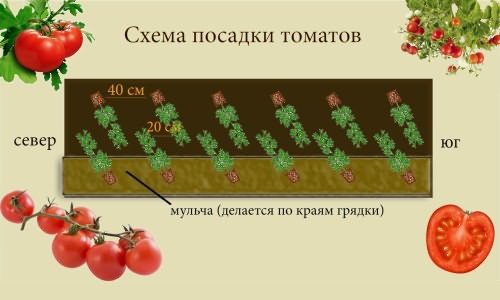
Excellent taste, wide distribution, high productivity and varied application led to the popularity of tomatoes.
Growing tomatoes can be done in a closed and open field at the dacha. It is necessary to take a closer look at what the value of the crop is and how to grow tomatoes.
Valuable properties of tomatoes
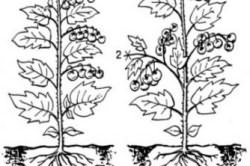
Tomatoes are isolated from all vegetable crops with abundant content of vitamins C, B1, B3, phosphorus, potassium, sodium, iron, calcium, magnesium, carotene, mineral salts, aromatic substances, sugars, citric and malic acids, fructose, lycopene.
The amount of nutrients depends on the place of growth, methods of cultivation, methods of care and other reasons.
Tomatoes are known for their antidepressant properties, vegetables have a positive effect on the gastrointestinal tract, nervous system, reduce the risk of cardiovascular diseases, have anti-inflammatory and bactericidal action, promote weight loss due to low calorie content. Every year, the popularity of tomatoes is growing.
Planting tomato seedlings on seedlings
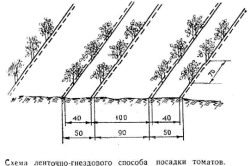
To grow tomatoes need a selection of good healthy seeds, which are used for planting seedlings. Before sowing, seeds are soaked in a nutrient solution. For the preparation of 1 liter of solution take 1 tsp. wood ash. It can be replaced with 1 tsp. nitrophosphate, 2 g of the drug "Bud", 1 tsp. liquid fertilizer "Effecton" or 1 tsp. fertilizer "Agricola-vegeta".
The selected drug is diluted in 1 liter of water. Soak the seeds in bags of fabric for 24 hours at a temperature of 20-25 ° C. Next, hold the hardening of seeds. A cloth bag with seeds is placed in a polyethylene bag and placed in a refrigerator for 2 days. Freezer can not be used. After this time, the seeds should be planted immediately in the previously prepared soil for growing seedlings.
The soil is prepared from equal parts of turf, peat, humus. On the bucket mix add 1 tsp. superphosphate, potassium sulfate, urea. The mixture is best heated in an oven for 20 minutes at 100 ° C. Lightly poured soil mixture is poured on a baking sheet with a layer of 4-5 cm and left in the oven. Then they start sowing seeds for seedlings in peat pots, which are sold in many garden stores. The pots are filled with soil mixture, not getting to the top 1 cm, watered with a solution for soaking the seeds. In each pot is placed 1 seed to a depth of 1-1.5 cm, the seeds are not watered on top.
You can use special cells and boxes for growing seedlings. In this case, the seeds are planted with an interval of 5-6 cm. Seeds for seedlings are sown 45-75 days before transplantation into open ground. Planted seeds are kept in a bright room (greenhouse, room) with a constant temperature of 22 ° C. The first watering of the emerged shoots is not great. The second watering is done in 14 days and combine it with top dressing. For the third time, seedlings are watered 3-4 hours before picking and transplanting.
Seedling care
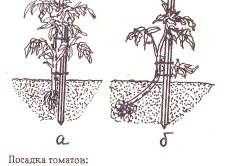
Care for seedlings is watering, feeding, airing. Boxes with seedlings should be turned daily to light by different sides so that the plants do not stretch out to one side. The first root dressing of plants is done when the plants have 1 true leaf. For fertilizing it is good to apply the fertilizer "Agricola-Forward", diluted with 1 tsp. its in 1 liter of water. The second root feeding is done with the advent of the 3rd true leaflet. In 1 liter of water diluted drug "Effect". The third dressing is carried out after picking.
Plants dive (seated) with the advent of the second sheet. Before planting for 2 hours, the seedlings are watered with potassium permanganate solution, spend 1 g per bucket of water, completely moisten the root system. Seedlings grown in peat pots, in most cases, do not dive. For picking use a box in which they put plastic, peat or cups of dense polyethylene, fastening them together with paper clips. Capacities under the seedlings are filled with soil mixture, they do not fill up to the edges 1-2 cm, leaving this volume for bedding, they are watered. Seedlings deepened to the middle of the stem.
12 days after planting, the plants are fed (third feeding). For carrying out dressing in a bucket of water dissolve 1 tbsp. l potassium nitrate and double superphosphate at the rate of 1/2 Art. fluid on the pot. 3 weeks before planting, tomato seedlings are trained to direct sunlight and a temperature of 15 ° C, hardened, while young plants are removed from the greenhouse for a day, after which they can be kept in the air at night. Hardened seedlings produce a wonderful harvest. The optimum age of tomatoes for planting in the ground - 2 months.
Choosing a place for planting tomato seedlings and preparing soil mixture
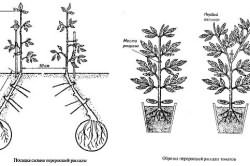
On the territory of the Russian Federation, planting time for tomatoes in the ground is limited. They are usually planted in the first decade of June, until that time there are threats of frost. Growing tomatoes is problematic in areas where solanaceous plants used to grow. This will hurt the growth of seedlings and further care for vegetables. Growing tomatoes is best done at the site of legumes, roots, greens, carrots, onions.
Tomatoes are in great need of light, the place for planting is given away by the sun, protected from the wind. For cultivation is not suitable wet areas with a close location of groundwater, adversely affecting the root system of tomatoes. This culture is not too demanding on the composition of the soil, fertile soils. The optimum acidity of the soil is pH = 5.5.
On sandy and loamy soils, mineral and organic fertilizers should be applied, and drainage should be done. During the growing season, the formation and growth of fruits, the need of tomatoes for nutrients increases, fertilization is required.
The main mineral nutrients of tomatoes are phosphorus, potassium and nitrogen. When phosphorus is deficient in plants, nitrogen is poorly absorbed, growth stops, and the set, formation and ripening of fruits is delayed. The plants are sick, the color of the leaves becomes blue-green, then gray. A lack of phosphorus causes the leaves to roll inward. At the beginning of growth is best to make superphosphate for the proper development of tomatoes.
With intensive growth, the culture needs nitrogen, and potassium is required for the proper development of the stems. Excess nitrogen leads to accumulation of nitrates in fruits, potassium neutralizes the harmful effects of soil acidity. On the basis of these properties of fertilizers, an ideal soil is prepared for tomatoes. It should include humus, manure, compost as nitrogen-containing components. Heavy loamy soils are relieved with sand. Moreover, 1 m² fertilize 2 tbsp. l superphosphate, 1 tbsp. l potassium sulfate.
Planting seedlings in the ground
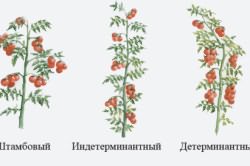
Types of tomato formation: (standard, indeterminate, determinant).
Before planting the seedlings in the ground, it is poured over with hot water, in which the potassium permanganate is dissolved, they take 1 g per bucket of water. At the same time, you can drive the stakes into the ground after 1 m, stretch the rope along the entire length of the plot. Then along the rope they dig a ditch with a depth of 35 cm, the bottom is treated with forks, and manure or humus is poured.
At the bottom of the ditch, after 1-1.5 m, pegs are set, between them, a wire or a rope is used to tie the plants. Seedlings, pre-grown in peat pots, planted vertically, with the pot just covered with soil, without removing the plant from there. Tall varieties and hybrids are planted in the middle of the ridge in one row, it is possible in a staggered manner, 50 cm and 1 m between the rows are left between the tomatoes.
Evening time is suitable for planting in the ground, cloudy weather in the daytime - it is important that the sun's rays do not adversely affect young plants that need to be acclimatized. Above the beds it is possible to install arcs of metal, to stretch a nonwoven covering fabric on them. This is an excellent protection for young plants from the burning sun and strong winds. The beds should be regularly weeded, mulched, fertilized. Watering takes place 2-3 times a week, bushes pile up, preventive measures are being taken to combat many pests and diseases.
Plants spud 10 days after landing in the ground. Before this, they are watered, moisture accelerates the growth of new roots, the second hilling is done after 2 weeks. At first, tomatoes are poured into the wells, using 0.5 liters of water per bush. Best time for watering - in the afternoon in cloudy weather. Obligatory watering is done during the flowering of the hands, before loosening and hilling, as well as after the application of mineral fertilizers.
Crop care and harvest
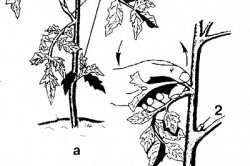
Over the summer, the culture is fertilized several times. To increase the yield of tomatoes and harvest in time, pasynkovanie - removal of lateral shoots. This contributes to strengthening the ovary, limiting flowering, reducing the number of unnecessary fruits that may be underdeveloped. Masking allows sunlight to fall on all plants evenly, it is necessarily carried out with the dense and luxuriant development of the bushes.
Growing soil tomatoes is associated with chemical treatments. They are performed 2 times before fruit set, it is recommended to use an effective drug Ridomil Gold. The first chemical treatment (spraying) is done after planting the seedlings in the ground after 10 days, the second - 10 days after the first. When the first fruits appear, it is best to apply Bordeaux liquid. It is prepared immediately before use.
To obtain 10 l Bordeaux mixture take 100 g of copper sulphate, which is dissolved in warm water in a 0.5 l glass jar. Then, the resulting solution is poured into another container of a larger volume, and 5 l of cold water is added. One more container is taken, in which 150 g of quicklime is placed and quenched with 5 liters of water, the lime milk is filtered.
While stirring actively, a solution of copper sulphate is added to the lime milk. If the resulting liquid has a bluish tint, does not contain flakes, with a neutral reaction, then it is prepared correctly. The reaction is checked by litmus paper, dipped in liquid. In this case, in a neutral medium, the litmus retains a purple color.
For spraying tomatoes with a Bordeaux mixture, clear weather without wind is ideal. For more intensive ripening of fruits on bushes, those that have begun to blush are removed, with a yellowish-brown color. It should be collected fruit without a stem, carefully folded in the container. In dry weather, they are dried. You can shoot green fruits of a large size, leave them to ripen in a warm, bright room at an air temperature of 20-25 ° C and a humidity of 80%.
Tomato is a valuable vegetable crop, which has high nutritional and taste qualities. With proper care For tomatoes, you can avoid many diseases of plants and increase yields.
VseoTeplicah.ru
How to grow tomatoes in open field: planting and care
Anyone knows how to grow tomatoes in the open field. Tomatoes grown in this way are very healthy and much tastier.
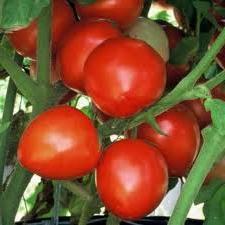
To understand how to grow good tomatoes without shelter, you first need to pick varieties that are suitable for planting in open ground. Usually prefer stunted tomatoes.
Before growing tomatoes in the open field, a lot of attention should be paid to seedlings. First, tomato seeds are sown in special disposable pots. Planting seeds in early March. In the pots you need to fill the ground and pits, a depth of about one centimeter. Further in the pits it is necessary to put one seed of tomato and cover it with earth. Then the pots are placed in a drawer in a warm place. Shoots begin to appear on the eighth day. It is possible to plant seedlings of tomatoes in open soil in a month and a half.
In order for the seedlings to be good, you need to care for her constantly and properly water. Once a week, tomatoes are watered with half a glass of water per plant; when the first leaves appear, they increase the watering to one glass of water. Also do not forget about the special dressings, which are held approximately once every ten days. The last dressing is done one week before the planting of tomato seedlings into the soil and for this purpose use a solution of superphosphate.
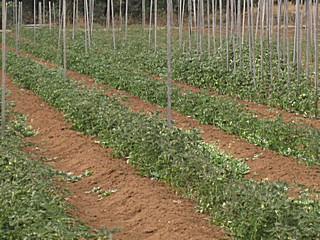
How to grow tomatoes in open ground? Do not forget to harden the seedlings of tomatoes. To do this, take the plant to a room where the air temperature is about 10 degrees. To the cold air, seedlings of tomatoes are taught gradually. First, the lighting is not used, and then gradually add light. Before you grow tomatoes in open ground, you need to plant seedlings. She should have about 12 true leaves.
Planting tomatoes in open ground is necessary on a sunny place where there should be no drafts, and in order to increase the yield, any of the leguminous plants should be precursors.
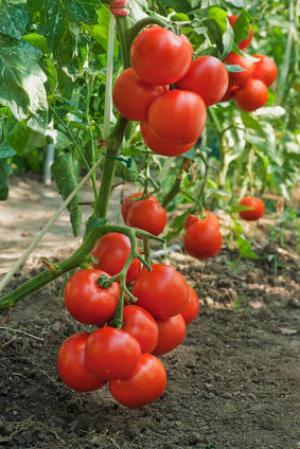
The preferred soil type is loamy, in which various mineral and organic fertilizers are added. Before preparing the future bed, it is necessary to thoroughly treat the soil with a warm solution of copper oxide. They need to water the soil - about 1.5 liters per square meter. Then fertilize the soil and dig the ground. Planted tomatoes in open ground in May. Seedlings should be planted vertically, and after about two weeks to spud the plants. If there are frosts at night, then the tomato seedlings should be covered with a film. It will also help protect seedlings from phytophthora disease.
Special pegs should be placed near the plants, which are intended for tying tomatoes. This will help them get enough light, oxygen and they will not get sick. After planting the tomatoes in the ground they do not need to be watered throughout the week, because they have to settle down well. With proper care and compliance with the rules of how to grow tomatoes in open ground, very tasty tomatoes very soon appear on your desk.
fb.ru
CARE OF TOMATOES IN OPEN GROUND
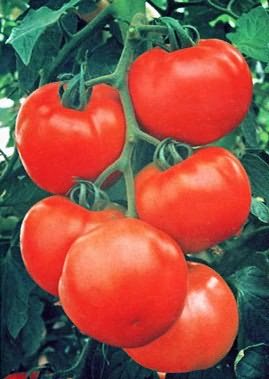
Caring for tomatoes at the same time is very simple if you are not chasing a particularly large crop, and at the same time troublesome if you want to get as much fruit as possible. The trick is that the tomato is not very demanding at all (it can produce fruit even when it is watered only occasionally and protected from weeds), but it is very responsive to almost all the agronomic measures that are pleasant for it. The better they take care of him, the more fresh tomatoes he will give. But taking good care of a tomato doesn’t mean that he needs a lot of it, on the contrary, a sense of proportion in caring for a tomato is the number one rule. After all, he does not like either excess water, or drought, nor a lack of fertilizers, nor overfeeding them, especially nitrogen, from which the bush will immediately begin to “fatten”.
Necessary care for tomatoes includes watering, feeding, loosening the soil, tying to the supports of tall varieties and their re-linking as needed, easy hilling, as well as weeding and, if necessary, protection from pests and diseases.
Watering a tomato
Tomatoes do not like either excess water or drought. They should be watered as the soil dries out, preventing it from drying out completely, rarely, but abundantly, on average once a week if there is no rain, and when they go, even that less often. The most important thing is that the tomatoes have enough water from the moment of formation of the ovaries and until the end of the pouring of the fruit. If at this time the tomato gets under drought, the ovaries can crumble, and the fruits that grow from those that survive will be atypically small. A little later, when they have already developed, the lack of watering can cause cracking of fruits. Most of all tomatoes like drip, or "underground", watering - where it is used, the yields are usually higher. If you water them in this way, as well as under the root or along the furrows and only in the evening, they will never get sick with top rot of the fruit. And here is another little secret: tomatoes are less likely to get sick and grow better if you add a little ash to the water for irrigation (a couple of pinch pits per ten-liter bucket). It will be better to bear fruit even if, as soon as the ovary starts to appear, sprinkle ashes around the soil (also about a handful per 1 m2). It is necessary to loosen the soil whenever you notice a hard crust on it, and it usually forms after watering or rain.
Top dressing tomato
Feed the tomatoes should be at least three times per season, and even better - do it all the time, every two weeks. Fertilizers can be used differently, the main thing is that they contain less nitrogen than phosphorus with potassium, for example: 15 g of ammonium nitrate, 50-60 g of superphosphate and 30-40 g of potassium chloride per 10 l of water. However, they also respond well to the bird droppings solution. Of micronutrients, magnesium and boron are most needed: magnesium is constantly, and boron is when they bloom, because from its lack flowers and ovary may begin to crumble. For feeding, you need to take 1 g of boric acid per 1 liter of water and spray the greens in the afternoon.
Tying a tomato to the supports
Tie up tall tomatoes it is necessary to the pegs immediately after the seedlings planted in a permanent place are well rooted and moved into growth, and in case of a seedless way - when the seedlings have 5-6 leaflets. Stakes should be driven into the ground from the north side to a depth of about 40 cm from the plant and at a distance of 10 cm from the stem. The height of the peg must be selected under the height of the variety (usually from 1 to 1.5 m). However, some varieties can be tied up and not to the pegs, but to a wire that is horizontally stretched between the rows (a trellis), tilting the plants from adjacent rows in pairs to each other. Then they will have a bit larger fruits (why it’s hard to say, but in practice it usually goes like this) and it is easier to clean them. This applies not only tall, but also sredneroslyh varieties.
Spud tomatoes need 2-3 times per season.
Tomatoes must be protected from weeds all the time, from the very first days, preventing weeds from growing. The most convenient way to do this is with loosening and hilling.
Shrub formation
But the formation of a bush and the removal of stepsons are techniques that we need not for the tomatoes themselves, but for us to get more good fruits.
It is not necessary to form bushes in all varieties (for some, only one main stem grows). Most often, one main stalk is left, but varieties with powerful stems and with small but numerous fruits can be formed into two stalks and three.
There is nothing difficult in the formation. If you need one stalk, you must remove all stepchildren that appear in the leaf axils as soon as they appear, not allowing them to grow to a length of 2-4 cm. and the ovary.
If you form a bush in two stems, leave a side shoot that appears near the first brush, and if at three, then besides it is also the strongest of those that appear under the second stem.
At the same time, the butchers should not be pulled out, but broken out, gently clasping them with their thumb and forefinger, and pull sideways, and not at themselves. If they managed to grow too large, they should be cut off with a sharply sharpened knife or razor.
One must constantly pickle tomatoes no matter how many stalks they have left. There is, however, one important limitation: during too much summer heat, it is better to temporarily refrain from cutting off the leaves and from pinching, because the bushes are badly tolerated by injuries. But if in the summer there are prolonged rains with a cold snap, it is advisable not only to pine the tomatoes, but also to remove parts of the shoots and all the lower leaves from them, so that the bushes get warm faster and become better ventilated.
In addition, for better harvest somewhere in the middle of August you should pinch the tops of all fruit-bearing shoots and remove those floral brushes on which the fruits did not start, then those fruits that have already started, will better flow and ripen faster.
Care of tomatoes in open ground
General care tips
Caring for tomatoes in the open field is not so difficult, especially if you do not chase over super-harvest. But to obtain a large number of fruits will have to be bothered. After all, by itself, this vegetable is practically undemanding: it gives fruit even in the case of simply periodic watering and protection from weeds. However, he is responsive to any concern. The more its - the more beautiful the harvest!
But this does not mean that the plant requires only large quantities. Just the first rule in the care of plants is a sense of proportion. Any extremes to anything:
- neither dryness nor overflow;
- no shortage of fertilizers - not overfeeding them (especially nitrogen).
The list of indispensable cases includes:
- top dressing
- garter to high-grade supports
- as required - the next tying,
- soil loosening
- protection from diseases with pests - according to the degree of need,
- weeding
We will give a few preliminary recommendations of a general nature. Since a tomato is a light-loving plant, it is better to grow it where it will receive as much sunlight as possible. For best growth, tomatoes need about two and a half liters of moisture daily. So watering should be done fairly regular.
And one more tip. Do not tear the fruit from the bush without making sure that it has finally ripened. After all, the longer it hangs on a branch, the more benefit and flavor it will have.
Planting plants in open ground
First of all, you should find out when to plant tomatoes in the ground. It is desirable to do this no earlier than the first summer days, considering, of course, the variety of the plant. Soil under the landing is prepared in the fall. The land is fertilized with manure. For digging they use superphosphate and potassium chloride (four hundred grams per ten square meters bring in up to three tens of centimeters).
If for some reason you haven’t fertilized the soil with manure, in early spring, when you need to harrow it, make two hundred grams of saltpeter per ten square meters (deepening to fifteen centimeters). In the spring you need to make and other fertilizers, if you do not do it in the fall. At the same time, Nitrofosc will perfectly go (600 grams per ten square meters) or a mixture of ash and compost (one half cup of ash on the compost bucket).
Seedlings planted better after dinner. During the night, it will be strengthened and much easier to cope with the transfer. To plant bushes, dig trenches or separated pits with a depth corresponding to the height of the pots in which the seedlings were grown. The bushes are then carefully removed from the containers and, together with the earthy clod, are transferred to the pit. Especially you need to pay attention to the root system! To remove the plants painlessly, at least an hour before the procedure, the seedlings are watered.
Early and undersized varieties are placed in rows with a distance of 60 centimeters (between bushes in a row - from 30). Tall varieties are placed at a distance of 70 centimeters between rows and 50 centimeters - between bushes. Also, the plants are organized Tenek using thick paper or cardboard.
Regular irrigation is especially important during the first time after planting. After watering, the soil between the rows is loosened to saturate the soil with oxygen. In a week - one and a half seedlings need to feed. To feed on a dozen liters of water mix 60 grams of garden mixture and 40 grams of superphosphate. Every 60 grams of garden mixture can be replaced by a dozen grams of ammonium nitrate. If the plant has become more powerful, full, and the ovaries are formed slowly, then from fertilizing will have to remove any nitrogen-containing fertilizers.
Watering and fertilizing plants
So, the planting of tomatoes in the ground is complete. Now they need care. Recall that they do not like aridity or overflow. It is necessary to water at the moment when the soil dries up, not allowing it to dry at all. They do it plentifully and rarely: once a week is enough, and if it rains even less often.
Plants should have enough water from the appearance of ovaries to the completion of fruit filling. In the event of a drought, the ovaries of the tomatoes easily crumble, but the fruits of the surviving "heroes" come out very small. And at the end of development due to lack of watering the fruit can crack. For these plants, the ideal "underground", or drip, watering, leading to maximum yield. It is also good to add ashes to the water for irrigation (for a 10-liter bucket - just a couple of pinches).
To improve fruiting, it is advisable to sprinkle the soil around them with the same ash when the ovaries appear. The soil requires loosening every time a hard crust is found. It appears, as a rule, after the rain with watering.
Tomatoes should preferably be fed no less than three times a season. Ideally, repeat this procedure constantly, once every two weeks. Fertilizers are suitable different, the main condition: potassium with phosphorus should be more than nitrogen. Say, a perfect mix for a dozen liters of water from five to six dozen grams of superphosphate, a dozen grams of ammonium nitrate and three to four dozen grams of potassium chloride. But it will go well and a solution of bird droppings.
Among micronutrients boron with magnesium (the first - only after flowering, from its shortage the ovary with flowers often crumble). Magnesium is always needed. Boron is taken in the proportion of 1 gram per liter of water and is applied after dinner.
We tie to the supports
Growing high bushes require garter tomato in open ground to the pegs. Carry out this, barely seedlings, being in a permanent place, rooted, going to growth. If the technique is seedless, if the seedlings have the first few leaves. Stakes are driven a dozen centimeters north of the plant to a depth of about 40 centimeters. Their length is chosen for plant growth.
Some varieties are allowed to tie to the trellis - wire, which is stretched horizontally between the rows. At the same time, plants from the “neighbor” rows are tilted in pairs to each other. The theory of this process is unclear, but in practice the fruits are larger, and it is easier to collect them. This applies to different varieties: both tall and medium.
At the same time, it is desirable to pile up bushes a couple of times during a season. To protect them from weeds will have continuously, right from the first day. Do not let weeds grow! It is easiest to do this in parallel with hilling and loosening.
We form bushes
The formation of each bush and getting rid of the stepsons are required more likely not for the plants, but for their owners - for obtaining a better harvest. True, they should not be formed for all varieties. Others and so grow with one main stem. As a rule, they try to keep him.
Although there are varieties, the stems of which are powerful, and there are many fruits, albeit small ones. In this case, the formation of a couple of stems, or even three. The more southern region you have, the greater the number of stems you can leave. After all, a warm and long southern summer gives time for the ripening of all the fruit to form. Although large enough, they will only be on the main stem.
To form plants is not difficult at all. If a single stalk is required, all stepchildren that arise in the leaf axils are removed. They do it immediately when they appear, not allowing them to grow even up to a couple of centimeters. Should begin with stepsons, which appeared directly under the leaves. Otherwise, the tomato often resets the ovary with flowers. If the bush is formed in a couple of stems, leave a side shoot that appears near the first brush. If in three - then also the strongest outlined under the second stalk.
However, the stepchildren do not break out, but break out. They are neatly wrapped around with their index finger and thumb and pulled not towards themselves, but to the side. When they have grown strongly enough, it is advisable to cut them off with a razor or a sharp enough knife.
Repeat the operation should be regularly, no matter how many stems they left. Do not forget, however, that during enough hot weather it is better to refrain from cracking and breaking the leaflets. Indeed, in such conditions, injuries are poorly tolerated by plants. In the case of a summer prolonged cooling with rains, it is better not to confine yourself to the pinching, but also to remove all the lower leaves with a part of the shoots. So the bushes will be optimally ventilated and heated.
And in order to make the harvest even better, in the middle of August, you can pinch the tips of the fruit-bearing shoots, as well as remove flower tassels on which the fruit could not be tied. Then the already established fruits, better filled in, mature more efficiently.
Growing tomatoes in the open field: all the secrets
Tomato is probably one of the most beloved and popular vegetables. There is not a single kitchen in the world where it is used. Tomatoes are added to salads, snacks, hot and cold dishes, they are pickled and canned. A huge amount of variety different varieties allows you to choose your favorite, and not one. Therefore, each owner home plot sure to plant tomatoes.
Choosing the right variety
When growing tomatoes in the open field, it is worth remembering that the varieties for it are special, different from the crops for greenhouse, as the planting and care of the tomatoes themselves differ, because in the first variant the vegetables are in more difficult conditions.
Varieties for greenhouses are afraid of temperature fluctuations, so they will be sick on open ground, and vice versa, tomatoes intended for it will not be able to get along in the greenhouse, giving a bad harvest.
In varieties intended for open ground, the ripening period is much shorter than that of greenhouses, they are more tolerant and resistant to cold. Most often this short and early ripe plants, sometimes sredneroslye. The most suitable for growing in open ground conditions are considered super determinant and determinant varieties.
A plus can be called the fact that the harvest has ripened before the onset of cold weather, a minus - small fruits and a short period of fruiting. The second - later, have more inflorescences and fruits are larger.
Who planting tomatoes is not the first year, have their own selected varieties that best grow on their soil. Seeds from them are carefully harvested for harvesting for the next season from the healthiest and most productive bushes.
If you buy seeds for planting for the first time, pay attention to all the nuances. Do not buy seeds in unverified places and carefully study the packaging - on the desired varieties will be the appropriate labeling.
One of the decisive indicators is ripening period tomatoes The easiest to care varieties that grow and mature quickly, but usually they are smaller and taste worse than those that ripen for a long time and are saturated with useful elements. Later varieties will bring excellent tasty harvest, but caring for them is more difficult. For open ground one of the most popular is:
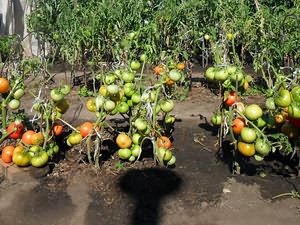
All these tomatoes are quite easy to maintain, bring a good harvest and are excellent in resisting diseases.
Seedlings - an important stage of the future harvest
If in southern places the seeds are usually sown directly into the soil, then in cooler latitudes it is necessary to start prepare seedlings. This is one of the most important stages, where you won't get a good harvest even when all other favorable conditions are achieved.
Seedlings require a lot of light and it is best to keep it on the south side of the windows. If it is not enough, sprouts must be provided with additional illumination.
Land for seedlings must be prepared in advance, even in the fall, but you can buy it in the store. The soil for growing is better to take more easy and not too fertileif it is too poor, dilute it with humus with a small amount of ash. If you take the soil from the beds, it is absolutely impossible to use the one that was under the tomatoes or potatoes.
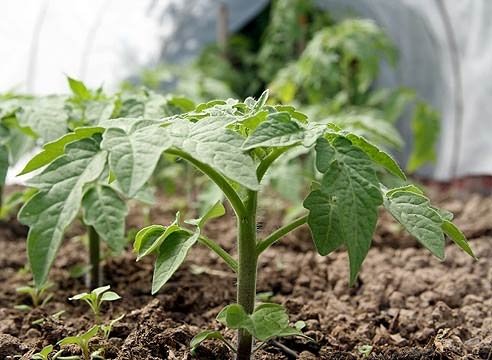 Seedlings can be bought and ready, but choose carefully! Sprouts should be strong, healthy, with no signs of yellowness. Too elongated and overgrown plants are not the best choice for landing.
Seedlings can be bought and ready, but choose carefully! Sprouts should be strong, healthy, with no signs of yellowness. Too elongated and overgrown plants are not the best choice for landing.
A few weeks before transplanting seedlings, it needs to be hardened so that the shoots can more easily adapt to the conditions of the open ground. For this seedlings periodically take out to the streetgradually increasing the time, in the end you can leave at night, if frost ended.
Landing dates
Terms of planting tomatoes in open ground depend weather conditions in your area. The warmer and faster end the cold, the earlier planted tomatoes. In the south, they start planting in mid-May, in the middle lane this is the end of May - the beginning of June, but in the north they are planted not earlier than the first decade of June and even closer to the middle of the month.
In addition to the above, the landing dates also depend from a variety of tomatoes and terms of their ripening. Ripening fruits are planted later, and those that ripen for a long time it is desirable to place in the ground as soon as possible.
Site selection and soil preparation
Far from all plots are suitable for growing tomatoes in the open field. To make tomatoes feel comfortable and give a good harvest, the landing site must meet certain requirements:
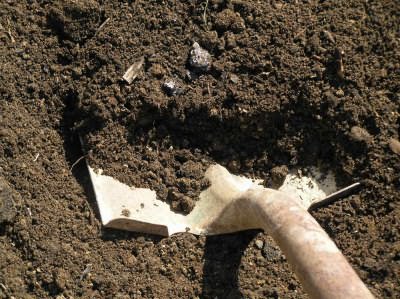
For growing this tasty vegetable Neutral acidity soil is best, lightweight loamy and sandyrich in humus. The soil for tomato seedlings needs to be prepared in the autumn. Fertilize it with manure, when digging use superphosphate and potassium chloride, after cleaning it and removing weeds and plant residues.
If the soil has not been fertilized in the fall, in the spring be sure to process it additionally with nitrate (to all of the above). Also useful mixture for tomatoes will be ash and compost (1.5 cups per bucket). The main thing - do not overdo it with fertilizers, as this will cause increased growth of the plant, but the fruits at the same time will be badly tied. After fertilizing the soil, let it relax for a couple of days and warm up, and only then plant the seedlings.
Landing
In order for the plants to ascend at the same time, plant them at the same depth. The depth of the holes should be identical to the height of the pots in which the seedlings were sprouting. In order not to damage the roots, the bushes of seedlings are transplanted along with a clod of earth.
This process is best spend in the evening, overnight, the plants will rest and more easily endure a change of scenery. Seedling in the hole is set vertically and covered with soil to the leaves, compacting around the roots.
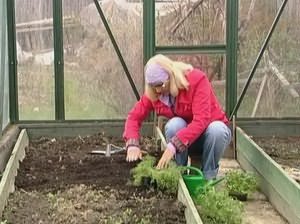 When transplanting seedlings from pots, the ground in them must be plentifully watered a day before this process. This will help to lose as little as possible of the roots of the seedlings, they should acclimatize and grow more actively, let's have an earlier harvest.
When transplanting seedlings from pots, the ground in them must be plentifully watered a day before this process. This will help to lose as little as possible of the roots of the seedlings, they should acclimatize and grow more actively, let's have an earlier harvest.
It is better to remove weak plants, as they will not develop normally, but at the same time they will draw nutrients from the soil to the detriment of the rest of the bushes. Correct landing will help sprouts quickly settle down and not lose the first flowers.
Tomatoes require a garter, so you can drive the pegs next to the seedlings immediately and tie them up at the height of the second leaf. In the future, tie up the bushes as needed. The height of the pegs depends on the type of tomato.
Tomatoes do not like the abundance of moisture, it can even lead to their death, but drought is tolerated quite tenaciously. Therefore, water the sprouts and adult plants with moderately warm (room temperature) settled water, allowing the soil to dry until the next time. The first two weeks after planting seedlings can not be watered at all.
Due to the stress in the process of transplanting, the bushes may start to wilt, but do not be scared ahead of time, the plants will get used to the change of scenery and recover.
Plant Care
Proper care of plants when growing tomatoes in the open field includes:
- frost protection;
- loosening the soil;
- watering;
- pollination;
- pest and weed control;
- fertilizer (top dressing);
- pasynkovanie and the like.
To protect the tomatoes from the cold, cover them with burlap or paper caps. With prolonged frosts, tomatoes need spud high, after their completion - release the plants from the ground.
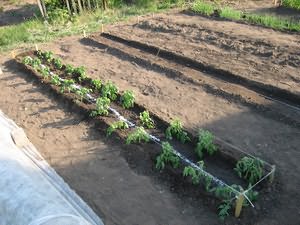 As already written - tomatoes do not like an abundance of water, so they are watered much less often than other vegetables. Early varieties need only water repeatedly per season, and mid-season - once a week or decade. Too much moisture can cause plant disease and decay, and the fruits will become watery and acidic.
As already written - tomatoes do not like an abundance of water, so they are watered much less often than other vegetables. Early varieties need only water repeatedly per season, and mid-season - once a week or decade. Too much moisture can cause plant disease and decay, and the fruits will become watery and acidic.
If heavy rains pass, watering should be reduced. But an insufficient amount of water will affect the quality of the fruit. For health and strengthen the bushes in the water, you can add potassium permanganate or ash. Watering tomatoes is best in the evening, at the root, without touching the leaves and stems.
Flowers of tomatoes form a sufficient amount of pollen, therefore pollination process they, in principle, carry out independently. However, they can be helped a little by planting mustard, basil or coriander among the plants with tomato plants - honey plants. This will attract pollinating insect flowers. Pollen is afraid of too low or too high temperature. In this case, the plants need help - slightly shake the bush or tap on the pole.
Masking
The formation of bushes is mandatory for tomatoes. Their bushes branch out strongly, forming many side shoots - stepsons, on which the ovaries also begin, but they do not have time to mature, while pulling the nutritive juices of the bush to the detriment of the rest of the fruits. Therefore, such shoots need to be removed at least twice a month. Cut not at the very stem, but retreating to a distance of about 1-2 fingers thick, while the shoots are young (3-5 cm). Longer branches better pinch off.
Carry out the procedure carefully, so as not to leave wounds that can get infections and diseases, moreover, the plant will receive stress, which will affect its health and the taste of the fruit. The best time for this process is the first half of a sunny day, then the wounds will have time to dry out and tighten.
Most do not need pasynkovke early ripening varieties, and the rest by August need pinch and stalk itself, as the further growth of the plant is not needed. This will save him the strength to form tasty tomatoes.
For the same reason, after the formation of fruits, bottom leaves plants are removed so that they do not take away the useful sap of the bush. It will be enough to leave only a few upper leaves, if the sun is moderate in your latitudes. If you are in the southern regions, leave the foliage to form a sufficient shade to the fruits.
Top dressing of tomatoes
Tomatoes are not choosy and do not require abundant fertilizer, especially if you have prepared the soil well. But, for good harvest, regular feeding is still needed. It is best to combine it with irrigation, after which to pile up the earth around the plant.
The first one is done not earlier than in a decade (maximum a week) after disembarkation. Fertilize superphosphate and ammonium nitrate in the ratio of 10: 5 grams per bucket of water. An excellent solution for a tomato would also be a solution of mullein or chicken manure.
Monitor the condition of the tomatoes to feed in a timely manner:
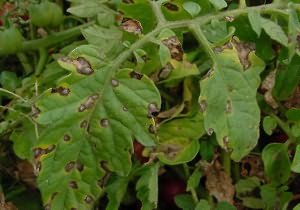
As soon as the plant begins to bloom, it is necessary to spray the so-called buds. foliar top dressing, to stimulate the formation of ovaries. It should be carried out in dry weather, preferably in the evening, with the following solutions:
- four parts of soda for one part of boric acid;
- one gram of boric acid per liter of water;
- a couple glasses of ash on a bucket of water.
In addition to helping the ovary, similar spraying excellent prevention plant diseases.
Harvesting and storage of fruits
Harvest when growing tomatoes in the open field begin at the beginning of August. Throughout the month, fruits are actively harvested, not waiting for their final ripening, since by the beginning of September they no longer mature.
Slightly unripe fruits (brown and yellowish) will return to normal in a couple of days and remain as tasty. Green tomatoes also ripen, if you pick them, however, will be worse. Fruits collected on time allow you to collect maximum yield.
For faster ripening, vegetables are stored in warm and bright indoors. If you want to delay ripening - hide them in a dark and cool place (but not lower than 10 degrees, otherwise the fruits will begin to rot).
ogorod.guru
Growing tomatoes in open ground seeds
Growing tomatoes in the open field has its own characteristics and difficulties. In the spring, as soon as the soil dries, I dig up the soil from the fall, fill the soil with organic matter with a rake or a manual cultivator, level it - this contributes to the preservation of moisture and the destruction of weeds. 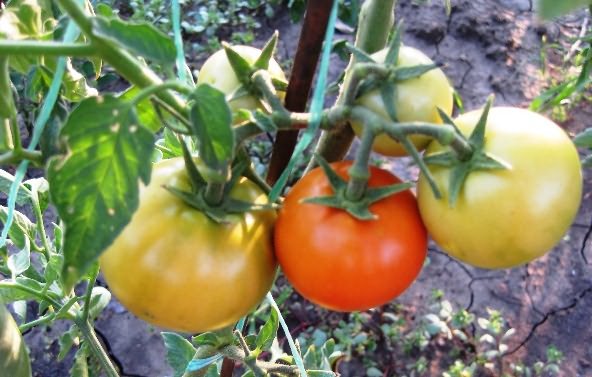
Choosing a site for growing tomatoes in open ground
Tomatoes are affected by the same diseases, pests as potatoes, peppers, eggplants. Therefore, I try not to plant them in the same place where these cultures grew before.
After all, disease-causing spores, viruses, pests live in the earth for several years. It is not recommended to sow tomatoes where they grew 3-4 years ago. Their proximity to potatoes is not desirable - this will help avoid late blight infection. The Colorado potato beetle won't get it either.
And the best predecessors of tomatoes are legumes, early white cabbage, pumpkins, zucchini, cucumbers, it is permissible to plant them after onions, late cabbage. Tomatoes placed in a sheltered area.
What varieties of tomatoes to choose
Many different varieties tested. Every year I reject some varieties, some I add. Now I am telling you about growing tomatoes from seeds in the open field. To do this, choose sredneroslye or often low-growing varieties.
Two years in a row planted Beta-Lux variety, I will plant it further. Really like. Low-growing variety, up to 50 cm high. Early maturing. Does not require staking. Red fruits. The flesh is juicy, sugary. Very tasty. Suitable for both salads and canning.
Variety Alpatieva 95A grown. I like the fact that it grows like a tree up to 50 cm high, sometimes lower, it does not bend, although there are enough tomatoes on the bush. Round fruits of good taste, not large. Variety resistant to phytophthora.
For many years in a row I plant Volgograd varieties of tomatoes. Like the fact that it is drought-resistant. Tomatoes are dense, suitable for salads, canning. Fruits almost frost.
This year, for the first time, I will sow the Novinka Kuban variety. Medium late variety for open ground. The plant is up to 40 cm high. The description on the bag promises high taste quality, resistance to phytophthora.
When and how to plant tomato seeds in open ground
After appropriate, conventional preparation, that is, heating, disinfection, washing, I germinate the seeds.
Different varieties require different time for germination - from 2-3 days to a week or even more. I try to equate it to April 10-15 (usually by this time the soil is ready for early sowing of vegetables). I make wide holes with a diameter of about 40 cm. I always pour the hole with warm water and potassium permanganate. I sow the seeds dry and sprouted mixed, evenly distributing them over the area of the hole. The expense of seeds at the same time turns out raised. But I do this for insurance.
Very often there was such a situation that during a cold snap or accidental frosts, the seedlings of germinated seeds died, had to replant. And from the dry seeds the plants will hatch later, they will avoid frosts, they will surely grow.
I also plant tomatoes in seedlings, but, as a result, all plants grown from seeds, catch up with seedlings, besides, they are stronger, stronger, less affected by diseases.
In the first one and a half to two weeks a lot of trouble with the emerged shoots. I don’t cover up my landings, they grow at the beginning, of course, very slowly.
Thinning of tomato seedlings
As soon as 2-3 true leaves appear, the seedlings should be thinned out. I try to leave those plants between which the distance is 5-10 cm. Of course, I leave the strongest plants.
The second thinning is done when small tomato plants already have at least 4-5 true leaves. Again I leave in the hole only strong plants, between which the distance increases - 12-15 cm.
Before the last thinning the hole is well spilled, I try to keep the ground very wet. Those plants of tomatoes that I decided to remove from the hole are not pulled out of the ground, but carefully dug out with a lump of earth. They can be transplanted to a new place or planted where there were weak shoots. Thus, in the final thinning, I leave 3-4 plants with a distance between them up to 40 cm. I try to grow the plants around the perimeter of the hole.
Care of tomatoes in open ground
Transplanted tomato bushes watered with a solution of Kornevin or Heteroauxin. You can spray them with a solution of NV-101 (1-2 drops per 1 liter of water) - it will “revive” them, it will help to better transfer the stress after transplantation. Well helps treatment drug Epin-Extra. I periodically process them with not only transplanted tomatoes, but also those that plant seedlings that remain intact in the holes. Epin-Extra increases the resistance of plants to diseases and adverse weather conditions.
Transplanted tomatoes, as well as those plants that have remained intact, should be mulched - pour sawdust, dry or mowed grass on top of the ground - so that the heavily moistened earth “does not take a crust”, does not dry out the next day. If you didn’t muddy the soil around the plants, then you should definitely loosen the ground. This should be done after each watering or rain.
Top dressing of tomatoes - open ground
In order for the plants to develop quickly and well, I do top dressing. I start them after the plants began to grow. I feed it with an ordinary mullein or chicken droppings - with what I have. I apply potassium permanganate (for 10 liters of water - 1 g of manganese-acid potassium) and sometimes 1 matchbox of urea - this is for foliar dressings. Korovyak I breed 1:10, and chicken manure - 1:15, sometimes I add 1 tablespoon of urea. The rate of irrigation is about 1 liter of solution per plant. It is necessary to feed on already watered, wet land.
As I grow, I weed out all the weeds, loosen the ground while simultaneously hilling the stem.
At the beginning of fruiting tomatoes, I try to sprinkle the soil with ashes, then loosen it, water it. I form low-growing tomatoes so that 2-3 stalks remain, and sometimes no form is required.
Tomato processing for pests and diseases
When the ovary reaches walnut, sprayed with new drug Tomato Saver. It protects tomatoes from late blight, macrospariosis, at the same time being a growth stimulator.
Previously, tomatoes were sprayed with 1% Bordeaux liquid or blue vitriol (40-50 g per 10 l of water). Sometimes I do 1-2 such treatments now.
Garlic infusion helps with diseases or pests: chop 1.5-2 cups of garlic with a garlic press or a meat grinder, pour hot water (but not boiling water), put a little potassium permanganate, add up to 10 liters of warm water, mix, strain. No need to insist! This solution can be sprayed. I alternate treatments every 6-10 days. For better adhesion add liquid soap. I do as needed 3-4 treatments.
Leaves at the bottom of the bush or yellowed leaves tear off. Experts claim that this technique speeds up the process of ripening, tomatoes - the fruits are larger.
To hurry the ripening of tomatoes will also help pinching the tops of fruiting shoots; under the fruits lying on the ground, put a plank or prop them with flyers; regularly ripen ripened or browned tomatoes.
This is my experience of growing tomatoes in the open field. Share yours - leave a comment!
ogorod23.ru
Growing tomatoes in the open field. My garden, garden. Piggy country experience.
- 5.2 Pollination of tomatoes
Hello, dear friends!
We continue the tomato theme. After reading the previous article, I hope you have learned something new about tomatoes, about the variety of varieties of this wonderful plant, about how to prepare tomato seeds and the timing of their planting, about caring for seedlings.
This article will discuss how to grow great harvest Tomatoes on our summer cottages, subject to planting in open ground.
So, the topic of our today's article - growing tomatoes in the open field.
Soil preparation for tomato princes
For a rich harvest, we need, first of all, to find a good spot for our pets. Tomato plants adore the indirect sun and will feel great on sunny, but sheltered sites.
- The best predecessors of tomatics are carrots, cucumbers and onions. And if you put your pets near strawberries, both cultures will benefit from this. The harvest of tomato and fragrant berries will increase several times, and the fruits will become larger.
But the places where they grew potatoes, eggplant and pepper should be avoided tomatoes. At these sites can accumulate pathogens of various diseases.
Our country is huge. And the quality of the soil is different in all regions (even in different fields). And tomato princes are very demanding and capricious to the earth. Therefore, we need to find out the quality of the soil in our garden.
◊ Check the acidity. In any garden department you can purchase a test to determine the pH level. The lower the rate, the higher the acidity. Neutral land has a score of 7.0.
- Tomatoes need soil with acidity indicators from 6.0 to 7.0.
In the case of a lower indicator, we add lime to the soil (0.5-0.8 kg per square meter), if the level is higher, sulfur is in the same quantity.
◊ Estimate the amount of nutrients. Analysis of the presence of trace elements can be ordered and carried out in special laboratories. This is very necessary information for gardeners.
It is necessary so that the cultivation of tomatoes in the open field takes place without loss and pleased with a rich harvest.
| Nitrogen | Phosphorus | |
| It affects the health of tomato leaflets. With its shortage, the tomato will have yellowed, sluggish leaves. | This substance gives tomatoes strength and health. It enhances the immunity and resistance of plants to diseases. With a lack of potassium, tomatoes grow poorly and look stunted. | It strengthens the root system and regulates seed formation. With its lack of tomatoes give sick, immature fruits. |
| If there is a shortage of nitrogen, add fish meal, compost or inorganic substances to the soil: calcium nitrate, ammonium sulfate or sodium nitrate. | To compensate for the lack of potassium, supplement the soil with sand, granite dust or wood ash (bucket per square meter). | To raise the level of phosphorus, add superphosphates, compost and bone meal to the earth. |
♦ Compost - ideal for soil preparation. It also attracts many earthworms, which do an excellent job of loosening the soil and, in turn, attract and create favorable conditions for the parthenogenesis of beneficial bacteria.
Prepare land for open field cultivation of tomatoes need to start in the autumn period after a thorough cleaning of all previous plant residues. The plot chosen for plants is dug up to a depth of 30 cm.
- Autumn top dressing. At a depth of 20-25 cm, organic (bird droppings, humus, peat or compost 5 kg per sq. M) or mineral fertilizers (potash salt 20-25 g, superphosphate 40-50 g per sq. M.) Are introduced.
- Spring dressing soil. At a depth of 15-20 cm, we bring in a mixture of bird droppings 1 kg, wood ash 1.5 kg and ammonium sulfate 20-25 g per square meter. Or mineral dressing (superphosphate 55 g, ammonium nitrate 20 g and potassium chloride 15 g per sq. m.).
For successful tomato cultivation 2-3 times it is necessary to dig up the ground thoroughly (better with pitchforks) and harrow. Like tomato plants and humus.
But it is better to refuse manure (tomatoes, having tasted manure fertilizers, begin to actively grow their tops, while the growth of fruits is extinguished).
- If the soil is not warm enough, you can cover the area with black film or plastic. Black color perfectly attracts the light of the sun and absorbs it, warming the ground beneath it.
On the prepared site, 5-6 days before planting, we form ridges (width 100-120 cm, height 15-20 cm) in the north-south direction. This will help to achieve uniform illumination of seedlings.
Stick to the distance between the ridges about 70 cm (for all varieties).
Growing tomatoes in open field
As soon as the end of spring frosts comes to an end (usually it is the end of May - the beginning of June), we will plant young tomatoes in open ground.
Carry out this procedure perfectly on a cloudy, gloomy day. If it's sunny outside, wait for the evening.
Planted young shoots in two rows with the distance between them during the classical landing:
- For short stumps and determinantal species (spacing between rows 40-50 cm, between plants 30-35 cm).
- For srednerosly (width of rows between 50-60 cm, between tomatoes 40-45 cm).
Square nesting
This method will greatly facilitate the care of our tomatoes (it will become easier to loosen them), and the plants themselves will create more favorable living conditions: they will improve the absorption of nutrients and will increase the illumination. As a result, we will achieve a good harvest. We land according to the following scheme:
- Standard and determinant varieties: 70x70 cm, 2-3 plants for one nest.
- Early maturity species with sprawling bush: 70x70 cm, a couple of plants in one hole.
- Middle and late ripening: 70x70 cm, 1 bush in one nest. Or 90x90 cm (100x100 cm) - 2 plants each.
Tape nesting
This method of growing tomatoes in the open field makes it possible to place more bushes in the same area. Loaded in one hole, it becomes easier to withstand bad weather conditions.
As they grow, weaker sprouts thin out.
- With this method, irrigation furrows are cut through 140 cm. Plants are planted on both sides of the furrows (from a row of 60 cm, in the row after 70 cm, a pair of bushes in one nest).
Focus on the final growth of the bush. Ideally, for good development it is necessary to provide about 0.3 square meters per tomato. m
On average, for a plot of 100 square meters. m. will need approximately 340-420 early tomatoes, and late and medium varieties of 240-290 pieces.
Getting Started
First of all, you need to moisten the ground well in pots or boxes with seedlings. This will help to easily remove them from the seedling containers and prevent accidental damage to the root system.
Prepared wells for growing tomatoes in the open field should have a depth of 10-15 cm.
We water them (a bucket of water for 8-10 holes) and apply mineral fertilizers mixed with humus (1x3 ratio).
- Turn over the seedling container, clasp the tomato trunk with your middle and index finger and remove it from the container.
- In the seedling, tear off the leaves, leaving only 2-3 leaflets on top (this will stimulate root growth).
- Place the plant with a lump of root earth vertically in the hole and sprinkle with compost. At the same time, the stem of the tomato must remain open. Only roots or a soil pot are placed in the ground.
- Press the ground firmly around the plant and dust the compost with dry soil.
- After planting, we mulch the soil (for this purpose, mowed, slightly faded grass, sawdust, straw or leaves of the newspaper will do). The mulch layer should be about 10 cm tall.
When the planting of tomatoes in the ground is over, we will leave them alone for 8-10 days. During this period, the plants take root and develop in a new place.
While they are not worth watering. But you need to be ready for frosts. To do this, immediately after disembarking, we will cover our young tomatoes with a transparent film.
It will remain until the threat of freezing disappears (for the middle band, this usually happens by June 5-10). Holes with a diameter of 10 cm can be made in the film. This will reduce the risk of late blight infection.
After 10 days, we water the seedlings and at the same time place the new one in place of the deceased. The first hilling when growing tomatoes in open ground can be done two weeks after planting.
In the future, we will spud the plants as they grow.
How to tie up tomatoes
Above the rows of planted tomatoes, place pegs 50-80 cm tall (depending on the growth of the bush).
The pegs are placed on the north side, retreating from the stem about 10 cm. We will tie each bush to them with a bast or twine.
Plants begin to tie up when they grow 4-5 true leaf. In total, 3-4 garters are produced during the growth period of the tomato.
Tie up plants only under the brush with the fruits. This allows them to be well lit and get more heat and sunlight, which accelerates and increases productivity.
Fruits that are not in contact with the ground are less susceptible to pest attacks and are better protected from diseases.
Tapestry method
For srednerosly plants, large-fruited and richly fruiting, it is best to use trellis, not garters.
This method of growing tomatoes in the open field makes it easier to take care of the plant, harvest, and lengthen the fruiting period of tomatoes. Plants rarely get fungal infections. This method allows you to effectively use the plot of the garden (especially when it differs in small size).
To do this, install columns about 1.2–1.5 m high in rows (the more often the posts are driven in, the stronger the construction will be).
On the poles every 20-25 cm hammer in carnations. To them with a twine or wire attach horizontal slats.
When tomato seedlings start growing (this will happen about two weeks after planting), gently tie the plant's brush to the slats with soft twine or cord. Continue to tie them as they grow every 15-20 cm.
- This method is ideal for growing tall tomatoes in greenhouses (we will talk more about the care of greenhouse giants in another article).
With the trellis method, further care of the plants will be very simple: timely garter of fruit-bearing shoots and their stepsons to the slats.
Care in the cultivation of tomatoes in the open field
|
Operation |
Tips |
|
| Masking of tomatoes (or shaping) | It is necessary to remove side shoots constantly, starting from an early age of the plant. By the time of ripening the fruits of the stepsons should no longer be. | They must be removed before reaching the shoots 3-5 cm in length. Best to do this in the morning. In the southern, sunny regions you can not completely remove the stepchildren, just do not tie them up. But in the north, this operation is required (leave only 2-3 stalks to each bush). In extreme heat, this procedure can not be. |
| Top dressing tomato | Once in 10 days. The first time we feed tomatoes two weeks after planting. | First feeding with a solution of mullein (1x10) or chicken manure (1x20). Repeated top dressings are made with mineral fertilizers (nitrophoska 60gr + water 10l). Quantity: before flowering 1 l each bush, after flowering 2-5 l. |
| Watering tomatoes | Abundant but rare watering. | In the spring and early summer, water the tomatoes once a week. In warm summertime, restrict one watering in 2-3 days. Water the bushes under the root in the evening. |
| Spraying | Spray every week, alternating compositions of the liquid. The first spraying immediately after landing in open ground (Bordeaux mixture). | Alternate the Bordeaux liquid and onion tincture made with your own hands. |
How to pinch tomatoes. When removing the stepsons, do not tear them out, but gently break them out by grabbing your forefinger and thumb. Carefully pull them sideways and break them off.
If they have grown too large, cut them with a sharp knife or razor. First of all, get rid of stepsons growing under brushes (otherwise a tomato can shed the ovary).
For a better harvest when growing tomatoes in the open field, at the end of the summer, pinch the tops of all the shoots with fruits.
Also remove excess flower brushes where the fruit could not form.
Preparation of Bordeaux mixture. We extinguish quicklime (100 g) in water and add water (about 5 liters). In another container in a small amount of hot water we dissolve a copper sulphate (100 g) and add 5 liters of water.
Then pour the solution of vitriol into hydrated lime. The correct fluid will have a sky blue tint.
Just in case, measure the indicator alkaline reaction ( bordeaux mixture should be neutral or weakly alkaline).
- You can use to check any iron objects. If the metal is covered with a layer of copper, you have made the solution too acidic. Need to add more lime. But do not overdo it, otherwise the liquid will lose its useful qualities.
Preparation of onion tincture. Grind minced onion turnip and garlic (100 g). We transfer the mixture into a 3 liter glass container and fill it with ¾ of water. Close and insist 3 days.
Shake it periodically. In parallel, in a plastic bucket, pour water on the bird droppings (200 g) and set to infuse. Before use, both mixtures are mixed and filtered.
Fertilized nettles and ashes are useful for dressing when growing tomatoes in open field.
Also, feed the plants with microelements a couple of times in a fruiting season (crush 5 tablets and stir them in ½ l of water, then add another 10 liters of water). Consumption of 1 liter per bush.
Banana fertilizer. We prepare natural, very useful top dressing, enriched with calcium and phosphorus. This tool is made from the peel of bananas.
- Cover the oven with food foil. Put a banana peel on top of the outer side down (so that it does not stick). Put the tray in the oven.
- After it is cooked and cooled, the peel is crushed into flour and placed in a sealed bag.
Sprinkle banana flour on the ground around the plant roots every other week.
To get a great harvest of tomatoes, you need not just properly water and feed them. They need pollination.
Pollination of tomatoes
A tomato is a self-pollinating plant. When growing tomatoes in open ground, these plants create a lot of high-quality pollen, which is also enough for neighboring flowers.
To help with pollination, attract insect helpers (bees, bumblebees).
To do this, plant bright annual honey plants between the tomatoes: rapeseed, coriander, basil and mustard. By the way, these cultures improve the taste of the fruits themselves.
But it is not always possible for a tomato to self-dust. There can be many reasons:
- Lowering the temperature at night (below + 13 ° C). In such conditions, the anther is deformed.
- Too high daytime temperature (above + 30-35 ° C). When heat flowers fall, and pollen grains die.
- Features of the pistil of some large-fruited varieties (it stands out and the pollen does not fall on the stamens). Or too wide pistil.
In such cases, you need to help pollinate our tomatoes. You can tilt down the buds with a protruding pestle and slightly shake the flower. Either easily tap on the trellis or blooming brush.
- The best time for artificial pollination is 10-14 hours, at a temperature of + 22-27 ° C. The ideal air humidity is no more than 70%. Repeat the pollination procedure after 4 days.
Immediately after pollination, water the tomatoes or spray them with water over the flower (so that the pollen adheres to the pistil). The flowers that appeared last are usually empty and underdeveloped. It is better to remove them immediately.
Secrets of growing tomatoes. An amazing tomato has one peculiarity - it is completely unpretentious.
And can bear fruit, even if your care will be limited to watering and weeding.
But the tomato is very responsive. And the more carefully you take care of the plants, the more harvest they will give you.
But do not overdo it in his desire to please him. The golden rule for growing tomatoes - everything is good in moderation!
Care of tomatoes should be within reasonable, competent limits!
Now, my dear friends, you know how to grow our precious tomatoes in the open field. Next we have to learn about the cultivation of tomatoes in the greenhouse and the possible difficulties (diseases and pests) in their cultivation.
And I also propose to watch a small video with several useful tips on growing tomatoes.
See you soon, dear friends!
syperdacha.ru
How to grow tomatoes in the open field: planting and care - Onwomen.ru
- 4 Harvesting
Until the 18th century, tomatoes were considered poisonous and were not eaten. But for such a relatively short time, tomatoes have gained incredible popularity, today they are the leaders in sales among vegetables, occupy the lion's share of landings in summer cottages, and a rare pantry with homemade products does without them. Growing tomatoes in the open field has many subtleties and nuances. To seedlings did not die in the early stages, the tomatoes did not hurt, and the harvest was abundant, it is necessary to responsibly approach this task from the very beginning. Start by treating tomato seeds before planting, and learn about the basic rules and valuable recommendations from experienced growers about growing tomatoes in the open field in this article.
Preparation of beds and soil
To prepare for planting tomatoes must begin in advance, most often they are engaged in this fall, so that everything will be ready by spring. Tomatoes are very sweethearted, so in the garden they emit an open sunny place. This culture can not be planted even in faint shadows or under trees, bright light and sunshine is required throughout the day. In low light tomatoes will grow poorly, do not ripen, deteriorate, and even if they reach the standard, their taste will leave much to be desired. Only grown in the sun, with proper farming, tomatoes are juicy and, as they say, sugar.
In the autumn, they begin to prepare the future beds for the tomatoes.. The quality of the soil is of great importance, it needs nutritious for tomatoes, therefore various fertilizers are applied to the ground. Thoroughly dig up the soil, remove weeds, roots, loosen. Manure or compost of about 5 kg per 1 m2 is added - these fertilizers can be applied only in the autumn, then they will overflow and enrich the soil with useful substances over the winter. In the spring they can not be used.
In addition to manure and compost, or in addition to them, 40-50 g of potassium chloride and superphosphate per square meter can be added. These fertilizers must be mixed with the soil, and not scattered over the surface.
But not always and not everyone is able to prepare the soil for tomatoes in the fall. In the spring, you can also go to the ground: for the cultivation of tomatoes per 1 m2 add 20 g of saltpeter, 60 g of nitrophobia, 1.5 cups of wood ash powder and a compost bucket. Fertilizers should be thoroughly mixed with the soil; compost can be additionally added to the wells.
Regarding fertilizers, this rule works: better under than re. If you overdo it with the application of fertilizers, then the tomatoes will actively pickles, which will negatively affect the development of the bush and the harvest.
Tomatoes often suffer from various kinds of fungi, this also applies to seedlings and adult bushes. Shoots die from black legs and other similar aggressive fungi, other diseases, various rot, mold, but no less dangerous, live in the open ground. Experienced vegetable growers recommend disinfecting the land before planting tomatoes; for cultivating the soil from fungi they use copper sulphate or copper chlorine.
Beds and holes for tomatoes are made a few days before planting seedlings. You cannot do this a day, because in this case the ground will be cold. Sometimes fertilizers are added directly to the wells, then they are poured abundantly with water and left for a day to warm the earth. The distance between the holes make 35-50 cm, depending on the variety, the distance between the rows is made larger - 50-70 cm.
Planting seedlings
The time of planting seedlings in open ground depends largely on the region. The variety has a slight effect, as for the open ground mainly used early ripening crops, which manage to bring the crop before the onset of cold weather. In central Russia, tomato seedlings are planted in early June, to the north - two weeks later, to the south - two weeks earlier.
In any case, before sowing tomatoes on seedlings, learn more about the variety you have chosen, whether it is grown in your area, whether the climate is suitable. There are adapted varieties for certain climatic zones, one variety grows well in the south, the other in the north.
So, the soil and the wells are ready, the earth is warmed, the water is absorbed. If the weather permits, then for planting tomatoes it is necessary to choose an overcast day, or to plant seedlings early in the morning or closer to sunset. Today, more and more often, seedlings are grown in separate peat pots, it is very convenient since the plant can be planted directly in the ground with it. After some time, the peat pot falls apart and the roots continue to develop further. If you have grown seedlings in plastic pots or pallets, then before planting it must be watered properly, then it will be easier to remove the bush from the ground. The hole should be the height of the pot, when planting, the bushes of the tomato are not buried, but in the future they are tucked. Do not be surprised if after planting the seedlings will become sluggish, it will wilt, it takes time to adapt. Why and advised to plant tomatoes when it is overcast or in the evening - so they quickly come to their senses. If you planted seedlings in the morning of a sunny day or during the night she did not have time to get stronger, then you need to protect her from the sun with the help of any shelter. You can shade as each bush separately, all at once. In the wilted state, seedlings can be several days.
Care
Do not think that after planting seedlings work with the ground is finished. This was not the case, the upper layer of soil should be mulched with rotted manure, peat, sawdust or chopped straw. This will prevent the emergence of weeds, protect the soil from drying out, make it more breathable. Soil loosening works very well on tomatoes, it enriches it with oxygen and tomatoes start to grow better.
OnWomen.ru
Growing tomatoes - Growing tomatoes (tomatoes) in the open field
Growing tomatoes (tomatoes) in the open ground
Tomato is the crop for which the protected ground is most suitable for growing, but this crop is also rather successfully grown in the ground and open, most often it is done for the production of raw materials and the canning industry. The yield of tomatoes in the average band is about 30t / ha (up to 50t / ha, that is 3-5 kg / m2, in closed ground, protected, of course, up to 35-45 kg / m2). But, it should be noted that the cost of a product grown in open ground is much less than the cost of a product grown in closed ground. For example, in 2003. the cost of tomatoes grown in the open ground was only 1.5-2 rubles / kg. But the cost of tomatoes that were grown in the closed soil was 10-12 rubles / kg.
The main disadvantage of tomatoes is often considered to be the fact that, in gardens in open ground, the fruits often simply do not have time to ripen to the end. But does this fact indicate that growing tomatoes in open field absolutely hopeless and, therefore, they should not be dealt with?
The fact is that if you look after the fact, the cultivation of tomatoes depends on how you grow them, what method of cultivation the amateur grower chooses, how the seedlings are prepared for planting in the ground, how the plants are formed, taking into account the morphological features.
In order to learn and understand how knowledge of the morphological features in the successful cultivation of a good tomato crop can help, it is necessary to know all the features of tomato growth. When a tomato grows, several leaves form on its stem, an inflorescence appears at the end of the stem, after which the plant stops growing. After that, a lateral shoot of the lateral bud from the sinus begins to develop, which also develops vertically. This side shoot, ends its growth, with the advent of inflorescence. After one more side shoot begins to grow, then another, etc. Thus, it becomes clear that the stem of a tomato consists of side shoots successively replacing each other, the so-called podiums. Definitions of indeterminate and determinant varieties are based on the number of leaves formed on the podiums.
Indeterminate varieties
These are varieties that have from 3 to 5 leaves on each new shoot, they can also grow indefinitely in height. These varieties are great for growing indoors, it is there for these varieties you can create ideal conditions for long-term growth. For example, varieties: hybrids varieties "Raisa", "Kunero", "Blagovest" and others.
Determinant
These are the varieties which, so to speak, are weakly branching in which limited apical development and inflorescences are placed through 1-2 leaves or in general in a row. These varieties almost do not need the staking process and can be well grown in unprotected soil. For example, varieties that go well to the canning industry are “Sunny” and “Lunniy”, while “Semko 89”, “Soil Gribovskiy 1180” and others can be used fresh in the open, and can also be successfully grown varieties are semi-determinant.
Growing technology. Crop rotation
The best predecessors for tomatoes are: Cucumbers, legumes, perennial herbs, carrots and onions. Bad precursors for tomatoes are: all plants belonging to the family of nightshade, namely eggplant, potatoes, physalis and pepper. Tomatoes can be planted in the same place of growth, not earlier than in 3-4 years.
Soil preparation
After the precursor culture has been removed from the site, it is necessary to grind all residues, this is done by the KIR-1.5 machine, and a shallow peeling by disc hoes of the LDG-10 type and the like. BDT-7 is also used to provoke more rapid germination of weed seeds. After 2-3 weeks, on the site you need to carry out the main deep processing, i.e. plowing the soil. If the site has a strong weed infestation by weed weeds, the following, special technology is used.
After the predecessor has been cleaned, soil milling or its double disking BDT-7 is applied. After the weeds grow, plowing is carried out. If the weather allows, then after the plowing was carried out, it is necessary to carry out another milling or disking of the soil. In the spring, when the soil comes to physical ripeness, it closes the moisture.
If the soil is heavy, swimming, or floodplain plowing should not be done in the fall, it is best done in the spring, after which milling is done. Before planting seedlings, it is necessary to conduct a rather deep cultivation of 12-14 cm, without rolling. If the soil has high humidity, you need to carry out shallow dump plowing.
Fertilizers
It is best to determine the rate of fertilizers for tomatoes by a calculation method, for example, here is the standard fertilizer for tomatoes: N - 60-120 kg / ha, P 2 O 5 - 60-100, K 2 O - 90-160. The main amount of fertilizer is usually applied for autumn plowing of the soil, and then for spring deep cultivation. When plants are planted, additional, complex fertilizers are applied directly to the wells themselves, for example, such as NPK at 15–20 kg / ha. Be sure to remember, and always take into account that in tomatoes grown in open ground, there is a maximum permissible level of nitrate content (MAC) is 150 mg / kg wet weight.
Growing seedlings
The seedless tomato cultivation method is practiced, as is known in the southern regions of Russia. But, here in the middle zone of Russia, the length of the growing season, unfortunately, does not give the opportunity to sow tomato seeds in open ground, we have to use a seedling method of growing tomatoes. Growing seedlings is quite possible in film greenhouses or greenhouses. Tomato seeds are sown approximately 55-65 days before the seedlings are planted in open ground (in other words, the sowing period begins in late March or early April).
The seeding rate is considered to be 8-10 g / m2. When sowing, the seedlings feed area should be from 3x3 to 4x4 cm. It is necessary to sow the seeds at an air temperature of +20 - + 25 ° C, after tomato seedlings appear, for 4-7 days, during the daytime the air temperature should be + 12 - 15 ° С, and at night +6 - 10 ° С.
One may ask, why is such a short-term temperature decrease necessary for plants?
This is done by the fact that the plant is in a critical position, i.e. there is a certain transition from nutrition due to the supply of the seed itself to the nutrition autotrophic. Also at this time, young seedlings in conditions of high temperature and not strong lighting, able to greatly stretch up and lie down. To last this period with a lowered temperature from 4 to 7 days, i.e. until the tomatoes have a first true leaf, (already the third in a general count after the appearance of the cotyledons). After the temperature rises again to +20 - 26 ° С on sunny days and is maintained around +17 - 19 ° С on a cloudy day, at night the temperature should not exceed +6 - 10 ° С.
In tomato, the root system is pivotal, and when tomatoes are grown using the seedling method, when picking and planting, the lower parts of the roots should be plucked from the plant. After the tomato picking has been done, the root system changes and begins to form from the lateral, horizontal roots, which are located in the so-called arable layer 15-25 cm. As a rule, picking should be carried out when there are 1-2 true leaves on the plant (it is necessary before the 3rd appearance). Approximately one hour before the start of the picking, the seedlings must be watered with copious amounts of water.
After the seedlings need to pull out with a clod of soil and shorten the root of the plant by a third. Seedlings need to be buried in the soil approximately on the seedbed leaves. When a picking is done, the plants are planted already over a large 8x8 food area. Humidity should be from 60 to 65%, strong ventilation is necessary.
The seedlings ready for planting in open ground should have from 7 to 9 leaves, single flowers on the first inflorescence, and the plant height should be 25-30 cm. The yield of tomato seedlings is 100-125 pcs / m 2. 330 for 1 hectare of open ground -360 m2 of protected soil, for sowing seedlings per 1 hectare of open ground, 300-400 g are needed
Transplanting
It is necessary to plant seedlings after the last spring frosts pass; this usually occurs at the beginning of summer. Seedlings are planted with seedlings, this is carried out according to the scheme 70x35 cm, (standing density ~ 40 thousand plants / ha) or 60x60 cm (28 thousand. Plants ha). When the seedlings are already planted, several heavy irrigations are necessarily carried out until the plants are fully established.
Plant Care
Be sure to loosen, which is the first time to be held soon after, as the seedlings were planted in the ground, the second loosening after 2-3 weeks, and then loosening held every 10 days. Irrigation use 3-4 irrigation (water consumption 250-300 m3 / ha). It is considered critical periods for seedlings in terms of moisture, this is when the ovaries form on the plants and the fruit is poured. If during this period the plants have a lack of moisture, then this will lead to abscission of the ovaries, small-fruiting, twisting of the leaves and the emergence of various diseases. If during the fruiting of tomatoes there is a sharp lack of moisture, this will lead to cracking of fruits.
You can protect the plants and seed treatment TMTD or other disinfectants. To protect the tomatoes from fungal diseases, spraying with a 1% solution should be carried out. bordeaux fluid after planting seedlings 6-8 kg / ha.
Semi-determinant varieties necessarily need to be staved, i.e. they definitely need to remove the side shoots, stepchildren. Due to the large laboriousness, tomatoes usually stepchild a maximum of 2 times, this is done at the beginning of July and 30-35 days before the last harvest, then you need to delete all stepchildren except the first and last. But if there is a possibility, ideally, tomato sticks are best about once a week. To speed up the process of fruit ripening a month before frost occurs, you can pinch the upper part, leaving only 2-3 leaves above the upper inflorescence.
Cleaning
Tomato harvesting is done several times, every 3-5 days. Tomatoes have several “levels” of fruit ripeness, they are distinguished as follows: green, milky, brown, pink and full (red). At maturity, pink and full, the fruits are harvested to be consumed immediately. To transport the fruits over long distances, they are collected in the milky and brown ripeness. Fruits in the stage of green and milky ripeness are harvested at the last harvest, for subsequent ripening and salting.
Harvesting is carried out most often by hand, or, less often with the help of TN-12, TShP-25 conveyors, POU-2, NNSSh-12A platforms, on large areas - SKT2A combine and sorting station SPT-15. In the open field, the yield of tomatoes is 30t / ha, up to a maximum of 50t / ha. Quite often, the fruits of tomatoes on the field do not have time to ripen. Green tomatoes contain large amounts of chlorophyll, starch, and very little sugar. For this reason, the fruits are removed in green and left to ripen at a later time.
Care for tomatoes in the open field
Caring for tomatoes at the same time is very simple if you are not chasing a particularly large crop, and at the same time troublesome if you want to get as much fruit as possible. The trick is that the tomato is not very demanding at all (it can produce fruit even when it is watered only occasionally and protected from weeds), but it is very responsive to almost all the agronomic measures that are pleasant for it. The better they take care of him, the more fresh tomatoes he will give. But taking good care of a tomato doesn’t mean that he needs a lot of it, on the contrary, a sense of proportion in caring for a tomato is the number one rule. After all, he does not like either excess water, or drought, nor a lack of fertilizers, nor overfeeding them, especially nitrogen, from which the bush will immediately begin to “fatten”.
Necessary care for tomatoes includes watering, feeding, loosening the soil, tying to the supports of tall varieties and their re-linking as needed, easy hilling, as well as weeding and, if necessary, protection from pests and diseases.
Watering a tomato
Tomatoes do not like either excess water or drought. They should be watered as the soil dries out, preventing it from drying out completely, rarely, but abundantly, on average once a week if there is no rain, and when they go, even that less often. The most important thing is that the tomatoes have enough water from the moment of formation of the ovaries and until the end of the pouring of the fruit. If at this time the tomato gets under drought, the ovaries can crumble, and the fruits that grow from those that survive will be atypically small. A little later, when they have already developed, the lack of watering can cause cracking of fruits. Most of all tomatoes like drip, or "underground", watering - where it is used, the yields are usually higher. If you water them in this way, as well as under the root or along the furrows and only in the evening, they will never get sick with top rot of the fruit. And here is another little secret: tomatoes are less likely to get sick and grow better if you add a little ash to the water for irrigation (a couple of pinch pits per ten-liter bucket). It will be better to bear fruit even if, as soon as the ovary starts to appear, sprinkle ashes around the soil (also about a handful of 1 m2). It is necessary to loosen the soil whenever you notice a hard crust on it, and it usually forms after watering or rain.
Top dressing
Feed the tomatoes should be at least three times per season, and even better - do it all the time, every two weeks. Fertilizers can be used differently, the main thing is that they contain less nitrogen than phosphorus with potassium, for example: 15 g of ammonium nitrate, 50-60 g of superphosphate and 30-40 g of potassium chloride per 10 l of water. However, they also respond well to the bird droppings solution. Of micronutrients, magnesium and boron are most needed: magnesium is constantly, and boron is when they bloom, because from its lack flowers and ovary may begin to crumble. For feeding, you need to take 1 g of boric acid per 1 liter of water and spray the greens in the afternoon.
Tying bushes to supports
It is necessary to tie tall tomatoes to the pegs immediately after the seedlings planted in a permanent place are well rooted and moved into growth, and with a seedless way - when the seedlings have 5-6 leaves. Stakes should be driven into the ground from the north side to a depth of about 40 cm from the plant and at a distance of 10 cm from the stem. The height of the peg must be selected under the height of the variety (usually from 1 to 1.5 m). However, some varieties can be tied up and not to the pegs, but to a wire that is horizontally stretched between the rows (a trellis), tilting the plants from adjacent rows in pairs to each other. Then they will have a bit larger fruits (why it’s hard to say, but in practice it usually goes like this) and it is easier to clean them. This applies not only tall, but also sredneroslyh varieties.
Spud tomatoes need 2-3 times per season.
Tomatoes must be protected from weeds all the time, from the very first days, preventing weeds from growing. The most convenient way to do this is with loosening and hilling.
Shrub formation
But the formation of a bush and the removal of stepsons are techniques that we need not for the tomatoes themselves, but for us to get more good fruits.
It is not necessary to form bushes in all varieties (for some, only one main stem grows). Most often, one main stalk is left, but varieties with powerful stems and with small but numerous fruits can be formed into two stalks and three. The more south you live, the more stems you can leave, because a long southern summer will allow time to ripen all the fruit bound. True, they may be smaller than on the main stem.
There is nothing difficult in the formation. If you need one stalk, you must remove all stepchildren that appear in the leaf axils as soon as they appear, not allowing them to grow to a length of 2-4 cm. and the ovary.
If you form a bush in two stems, leave a side shoot that appears near the first brush, and if at three, then besides it is also the strongest of those that appear under the second stem.
At the same time, the butchers should not be pulled out, but broken out, gently clasping them with their thumb and forefinger, and pull sideways, and not at themselves. If they managed to grow too large, they should be cut off with a sharply sharpened knife or razor.
One must constantly pickle tomatoes no matter how many stalks they have left. There is, however, one important limitation: during too much summer heat, it is better to temporarily refrain from cutting off the leaves and from pinching, because the bushes are badly tolerated by injuries. But if in the summer there are prolonged rains with a cold snap, it is advisable not only to pine the tomatoes, but also to remove parts of the shoots and all the lower leaves from them, so that the bushes get warm faster and become better ventilated.
In addition, for better harvest somewhere in the middle of August, you should pinch the tops of all fruit-bearing shoots and remove those floral brushes that do not have fruit, then the fruits that have already started, better flow and ripen faster.

